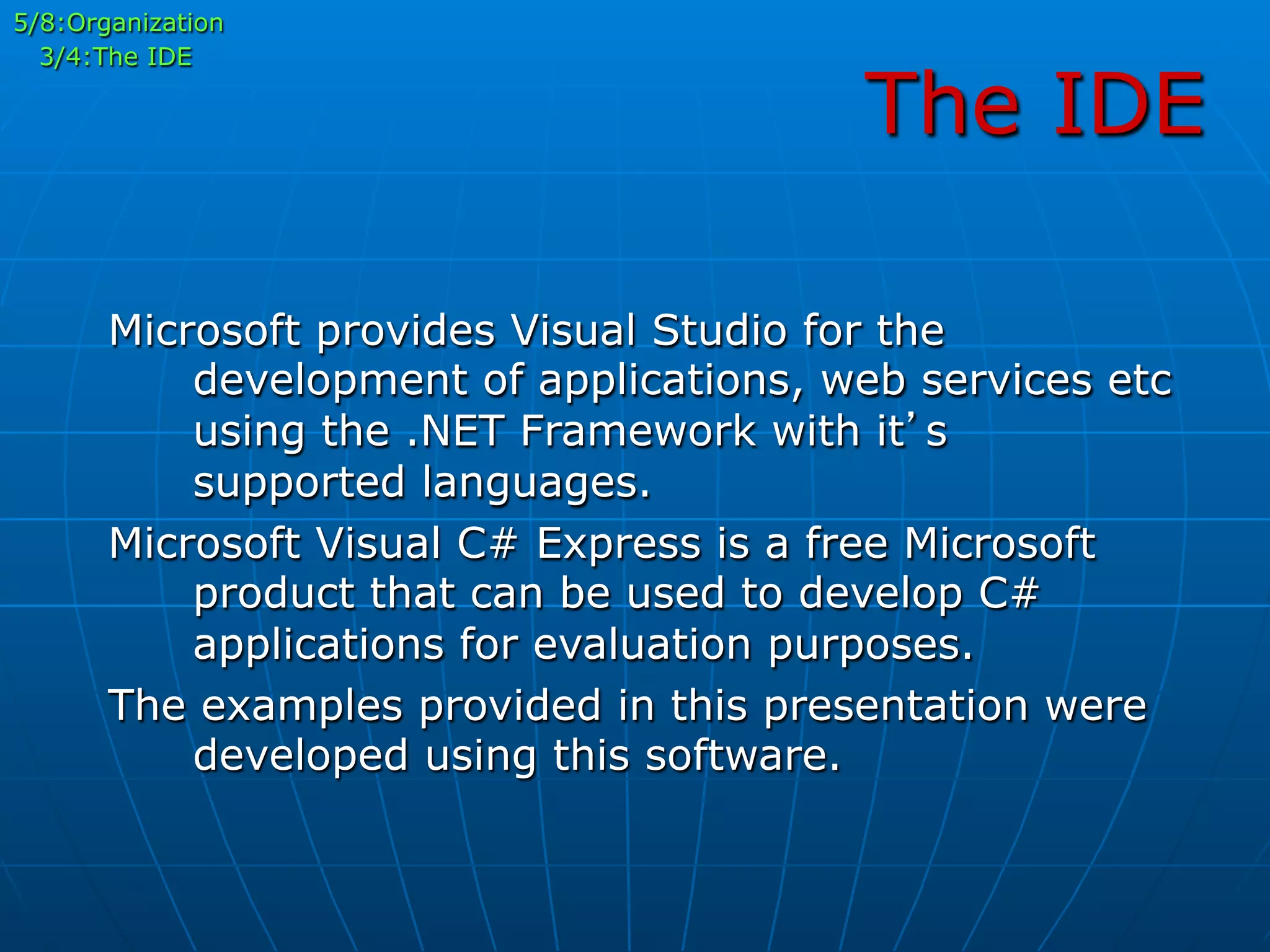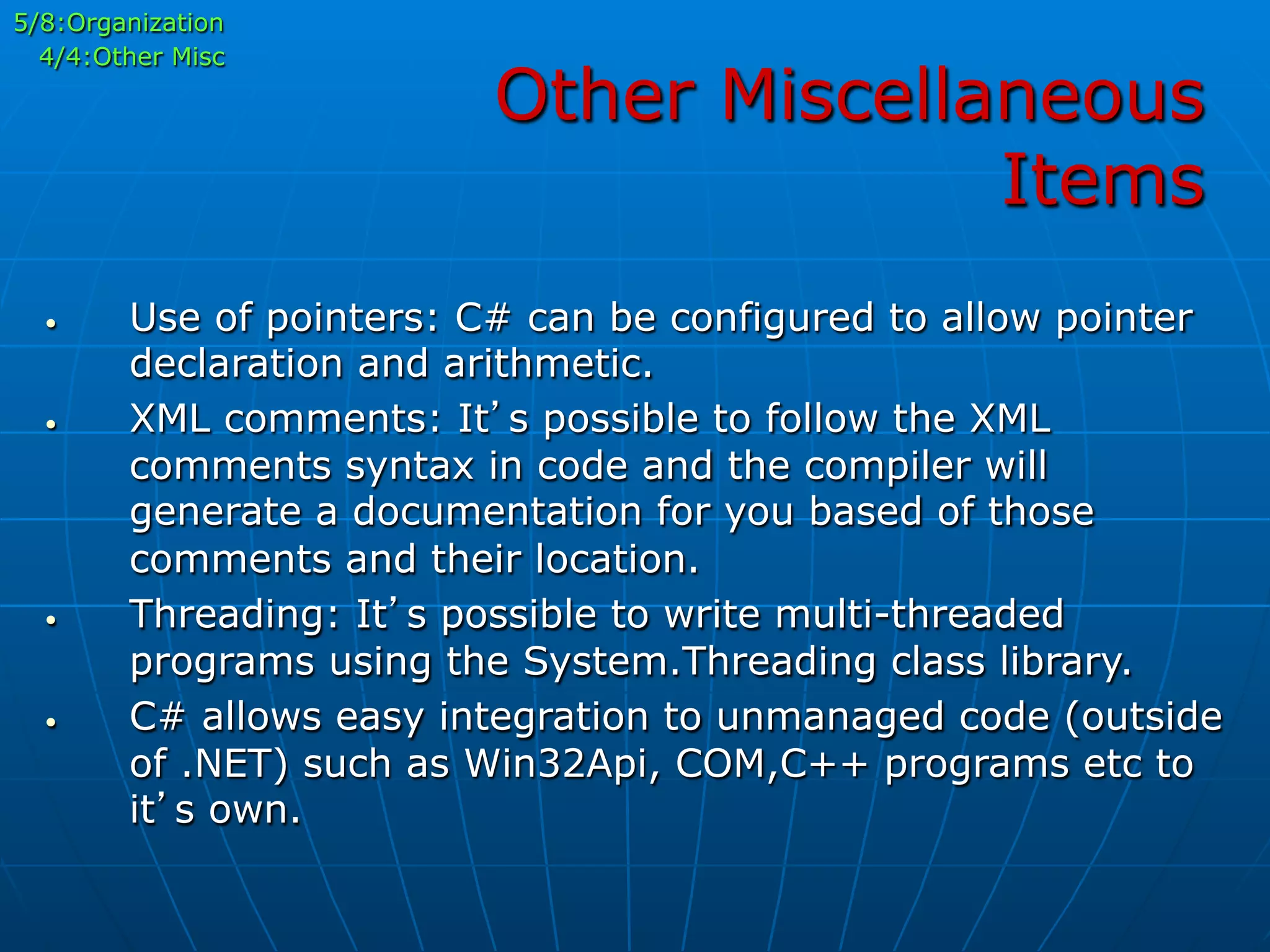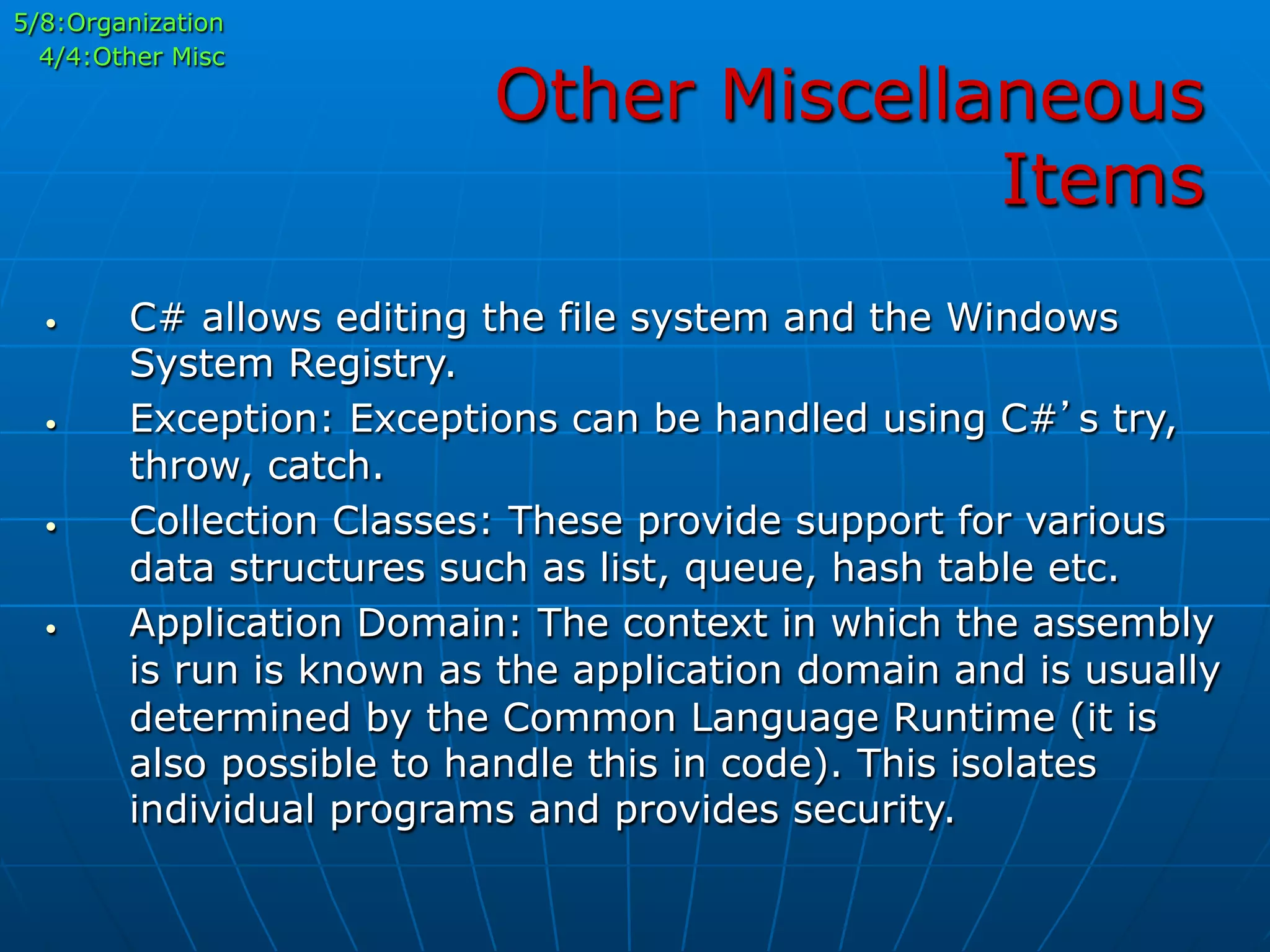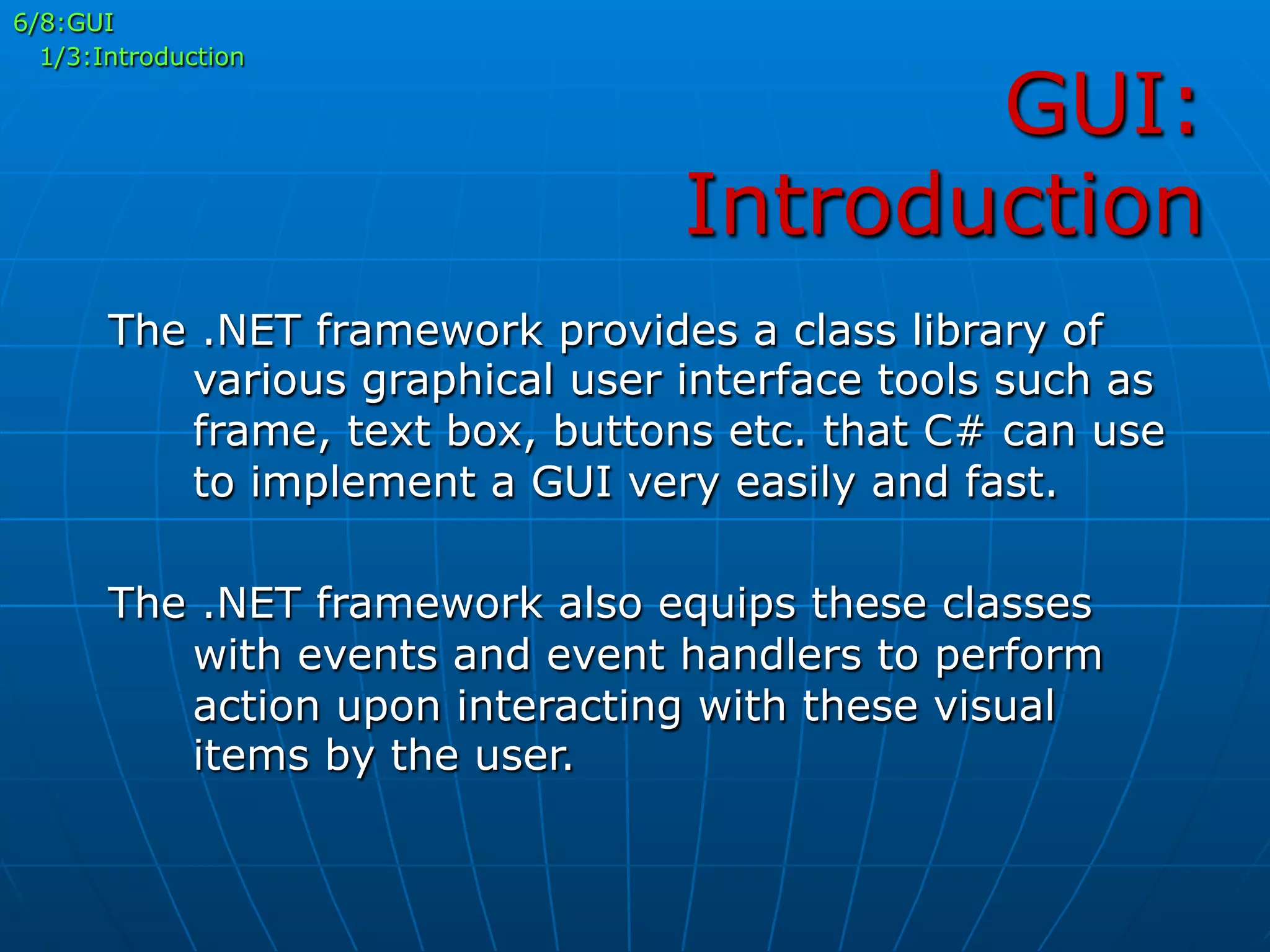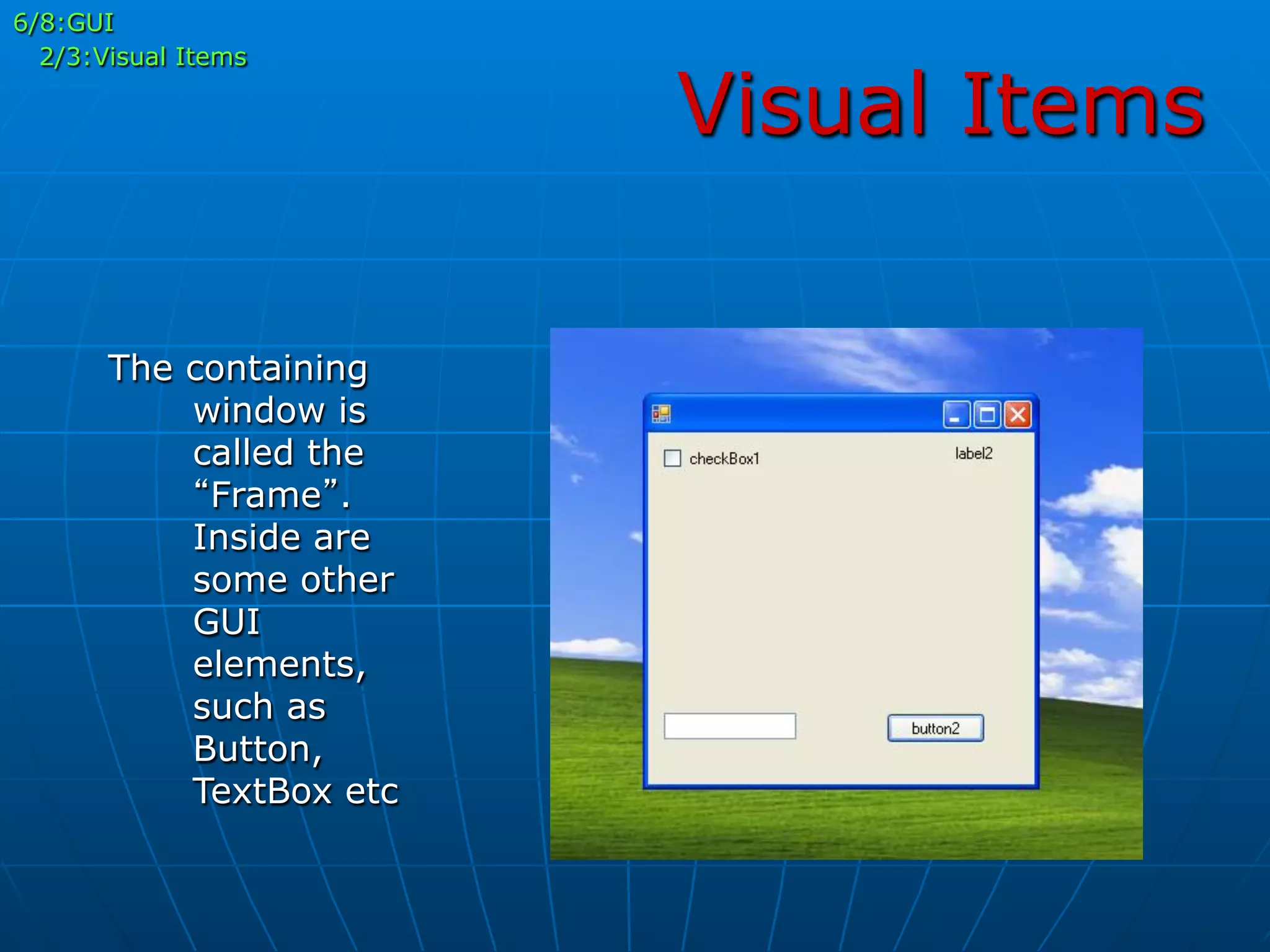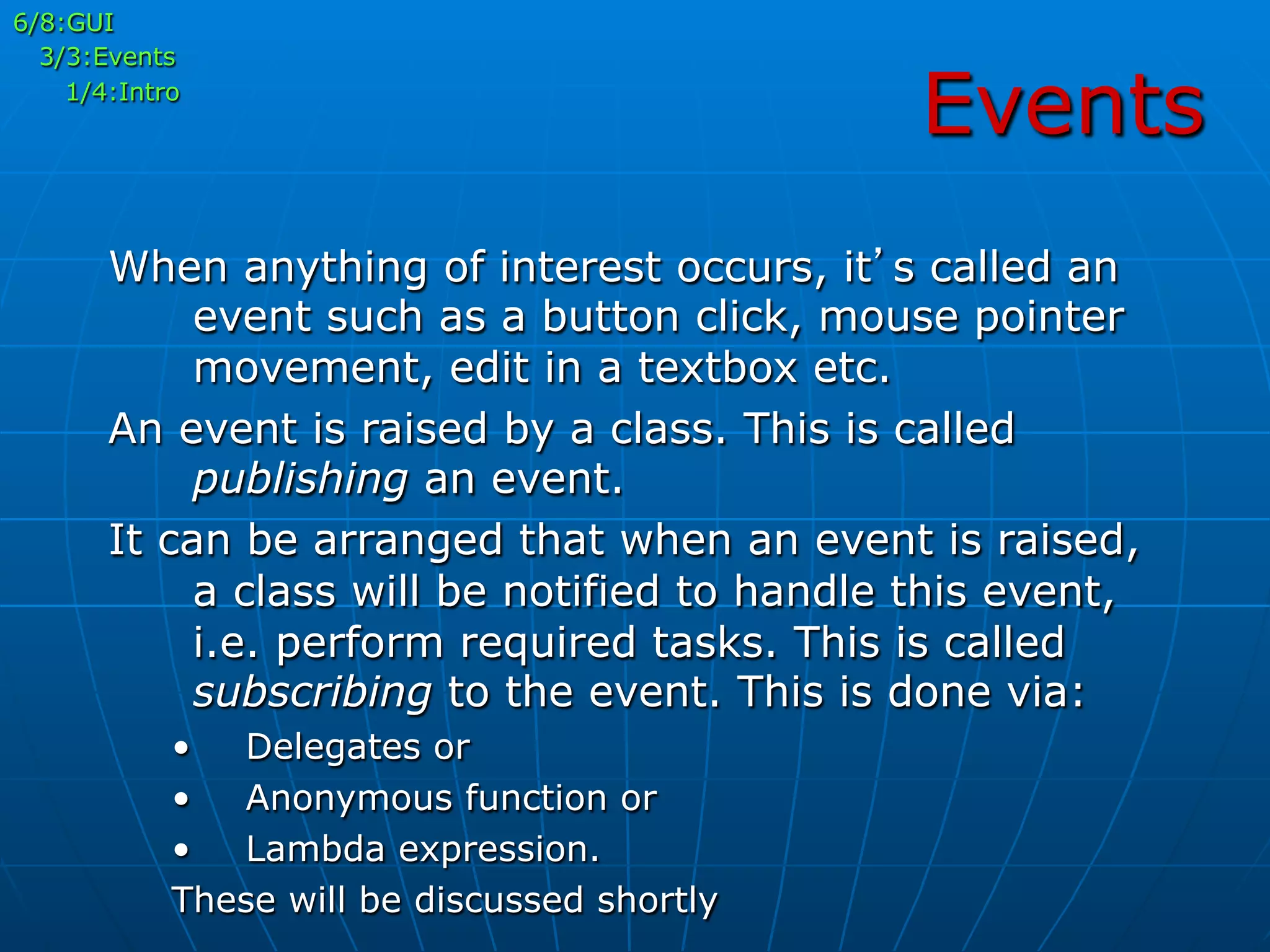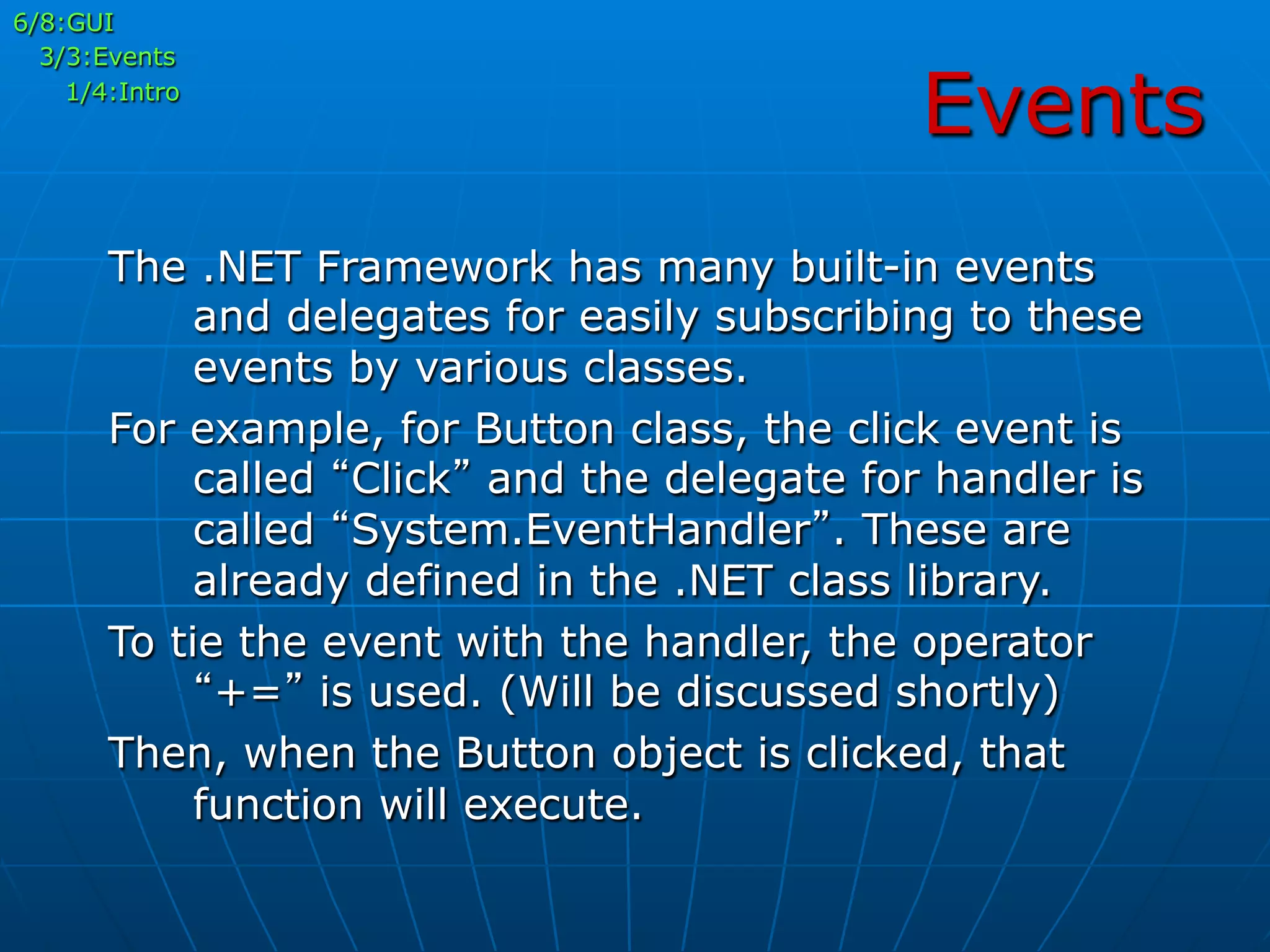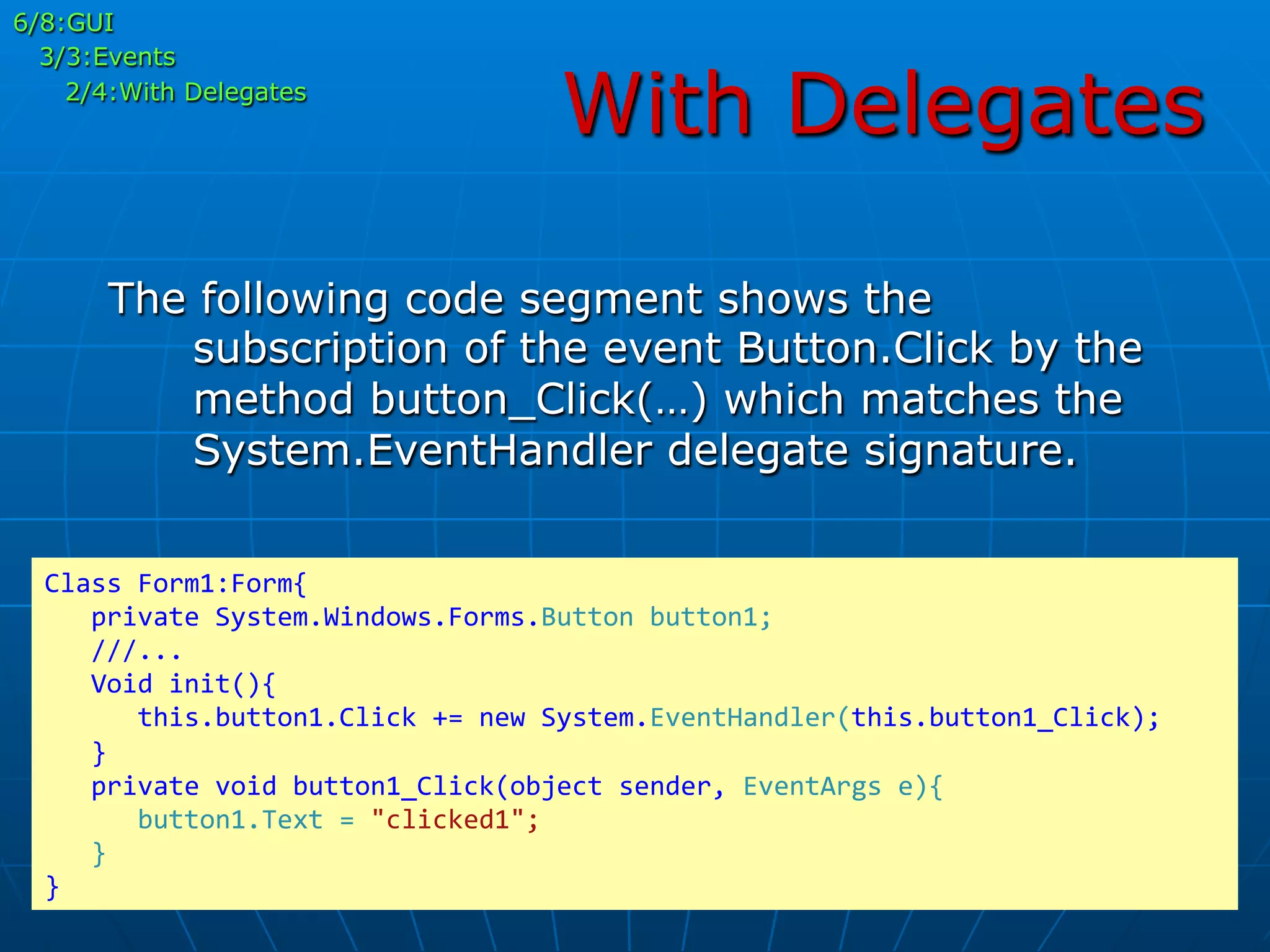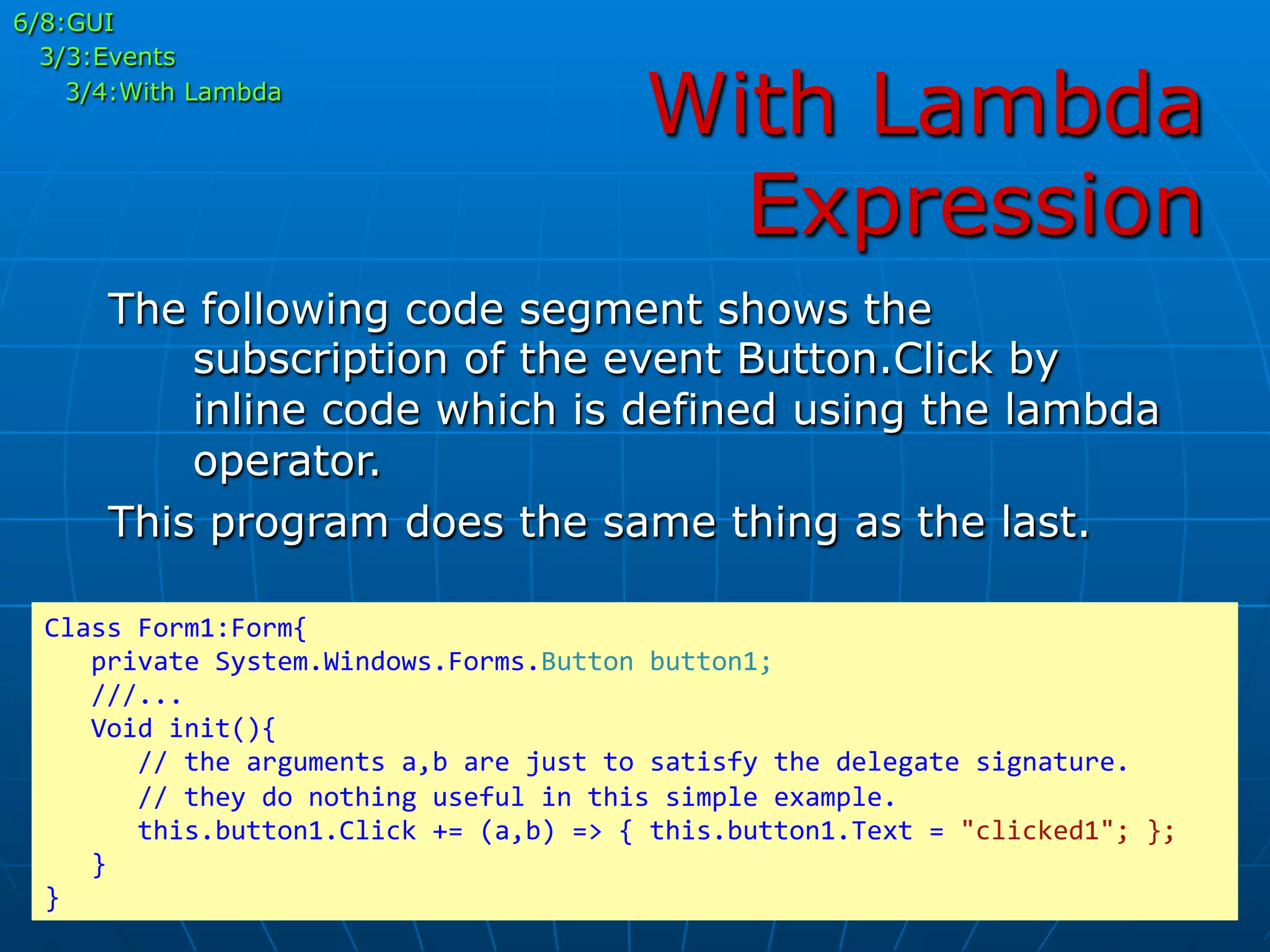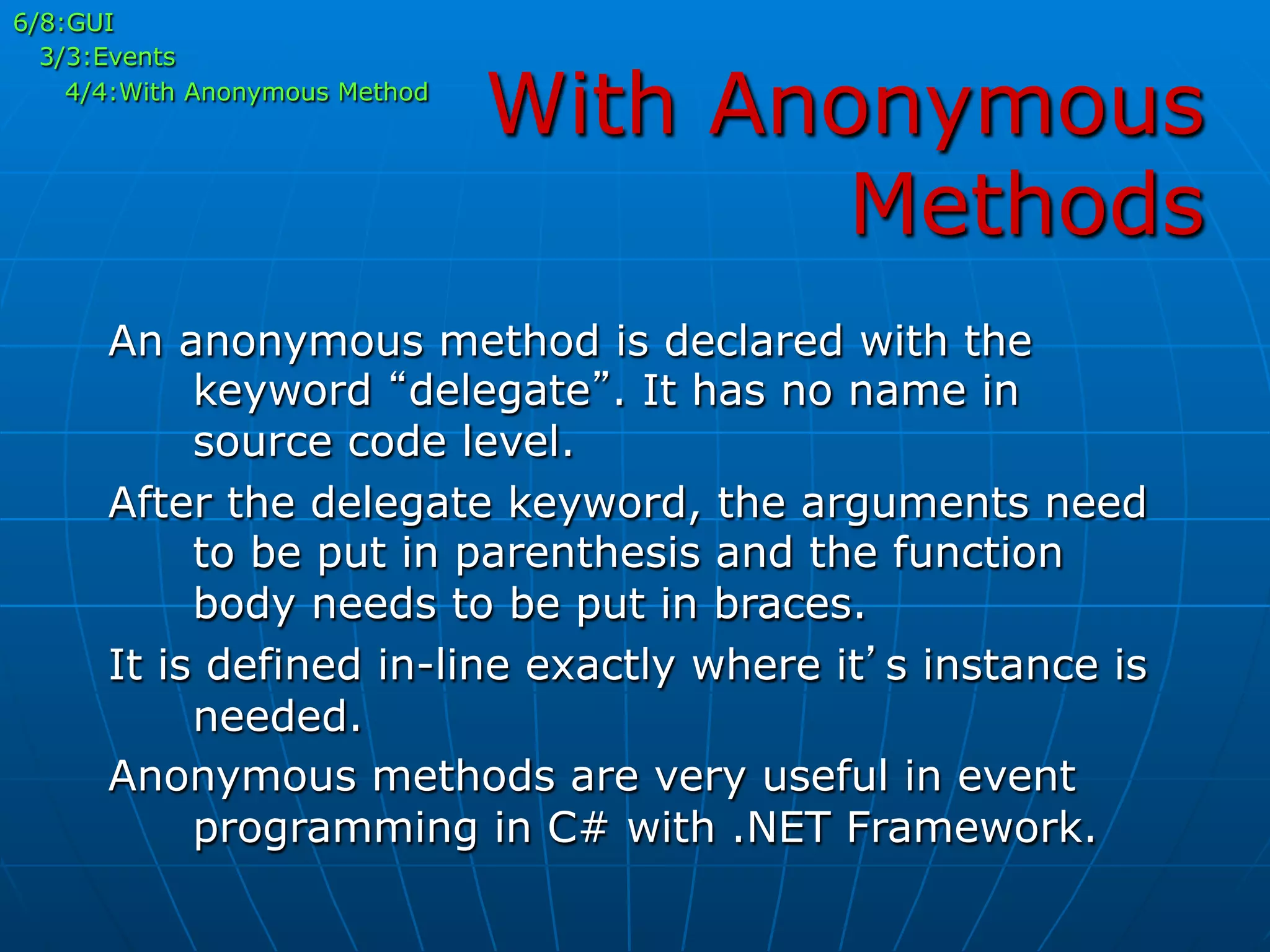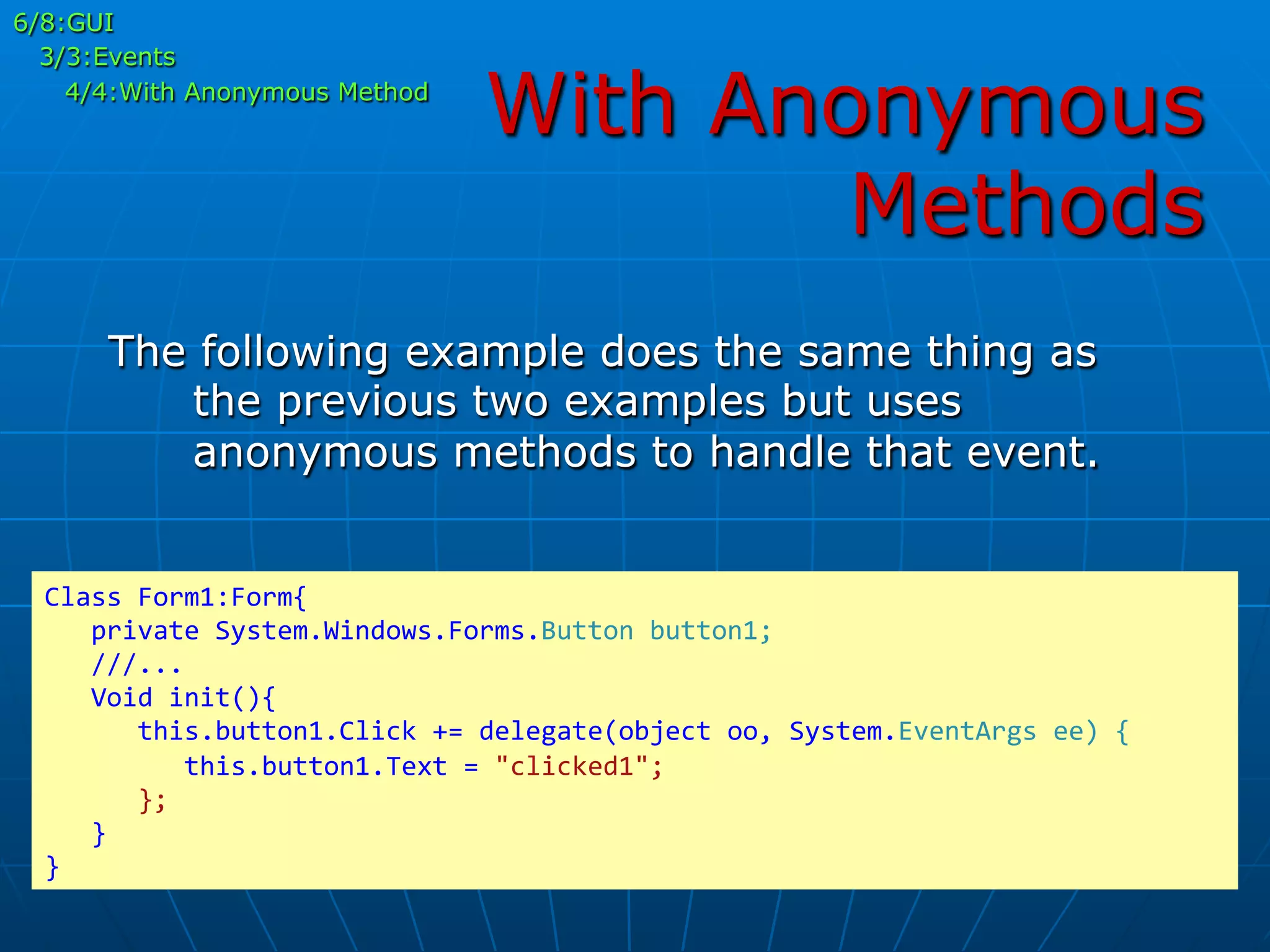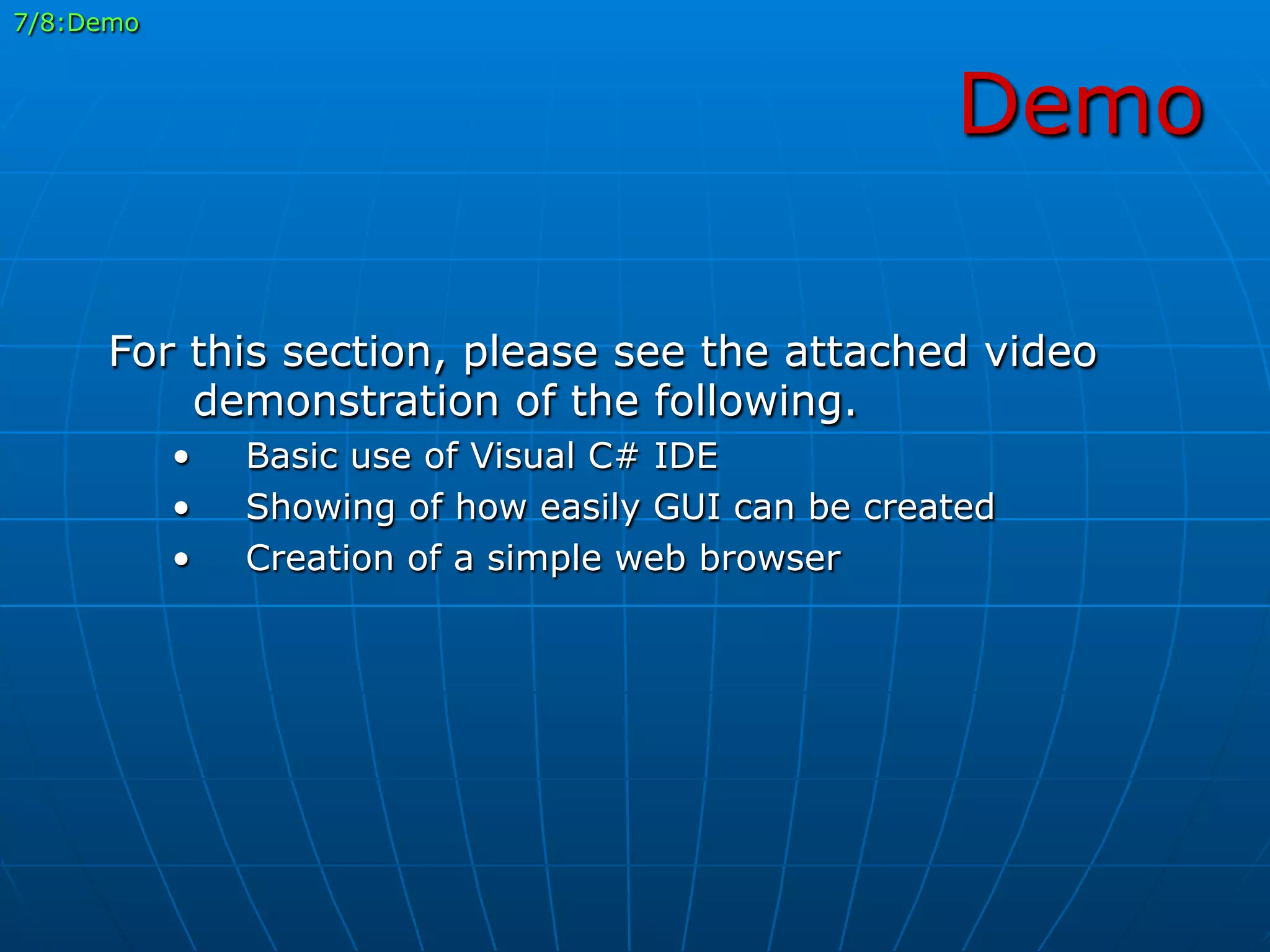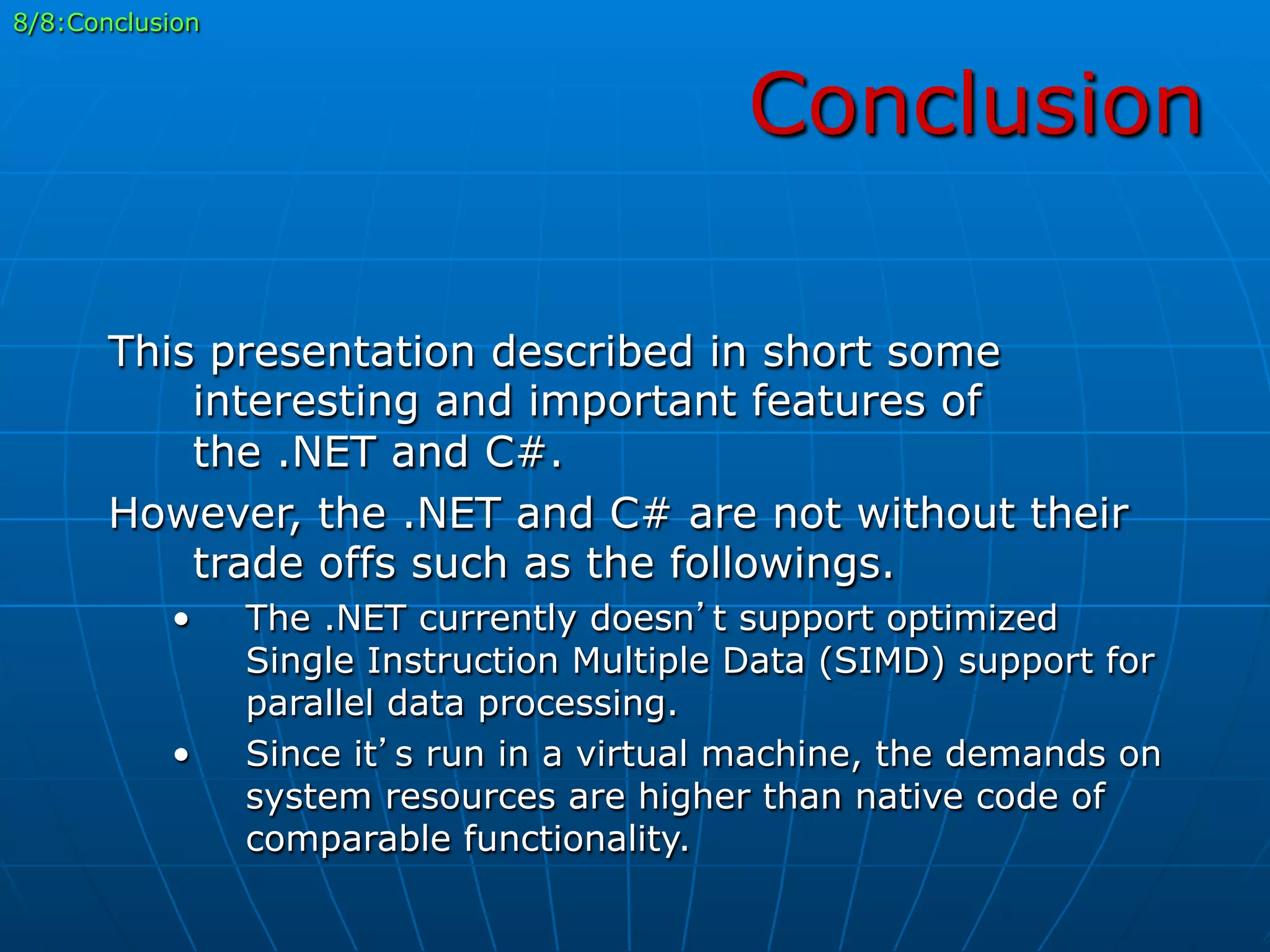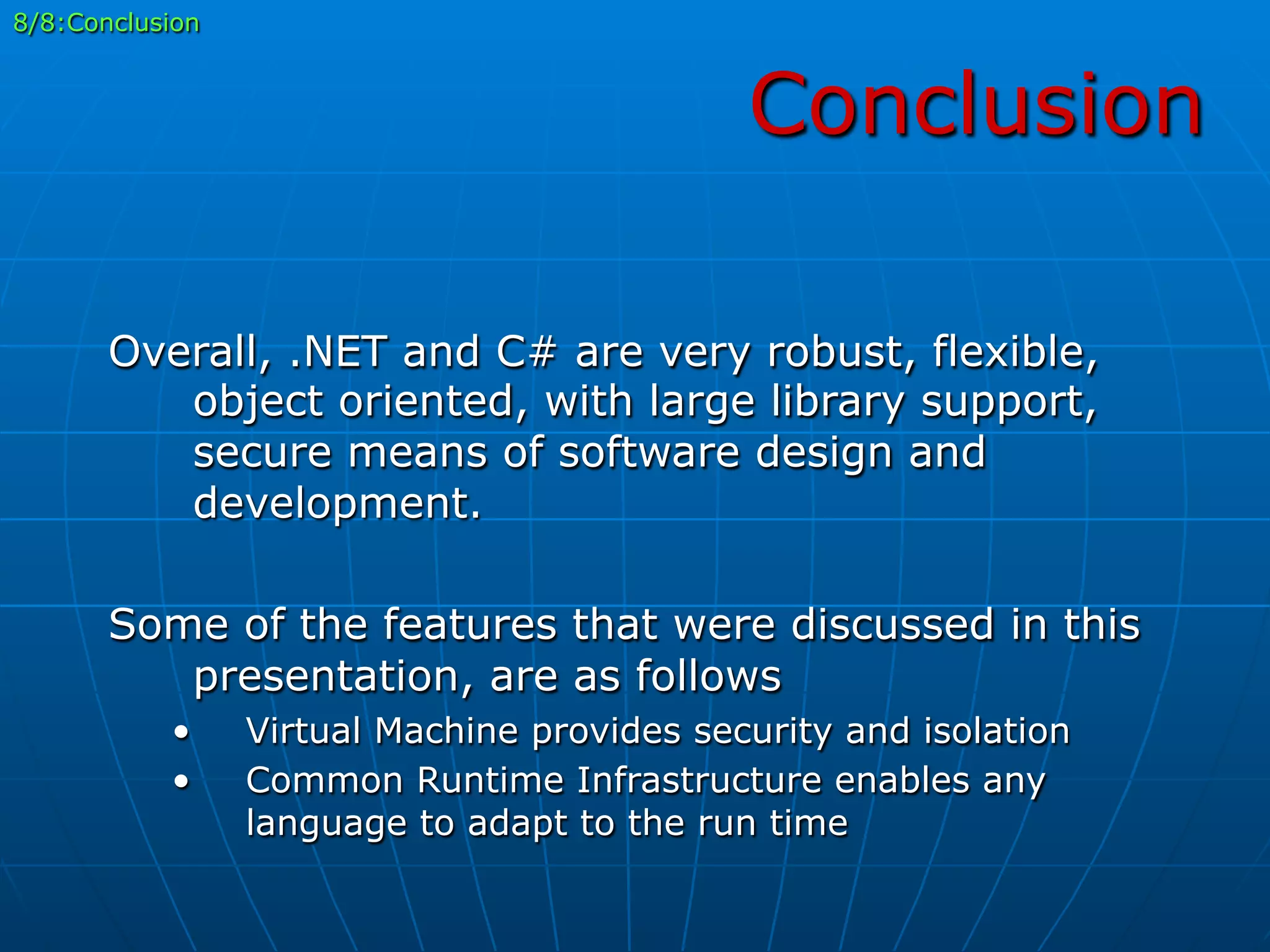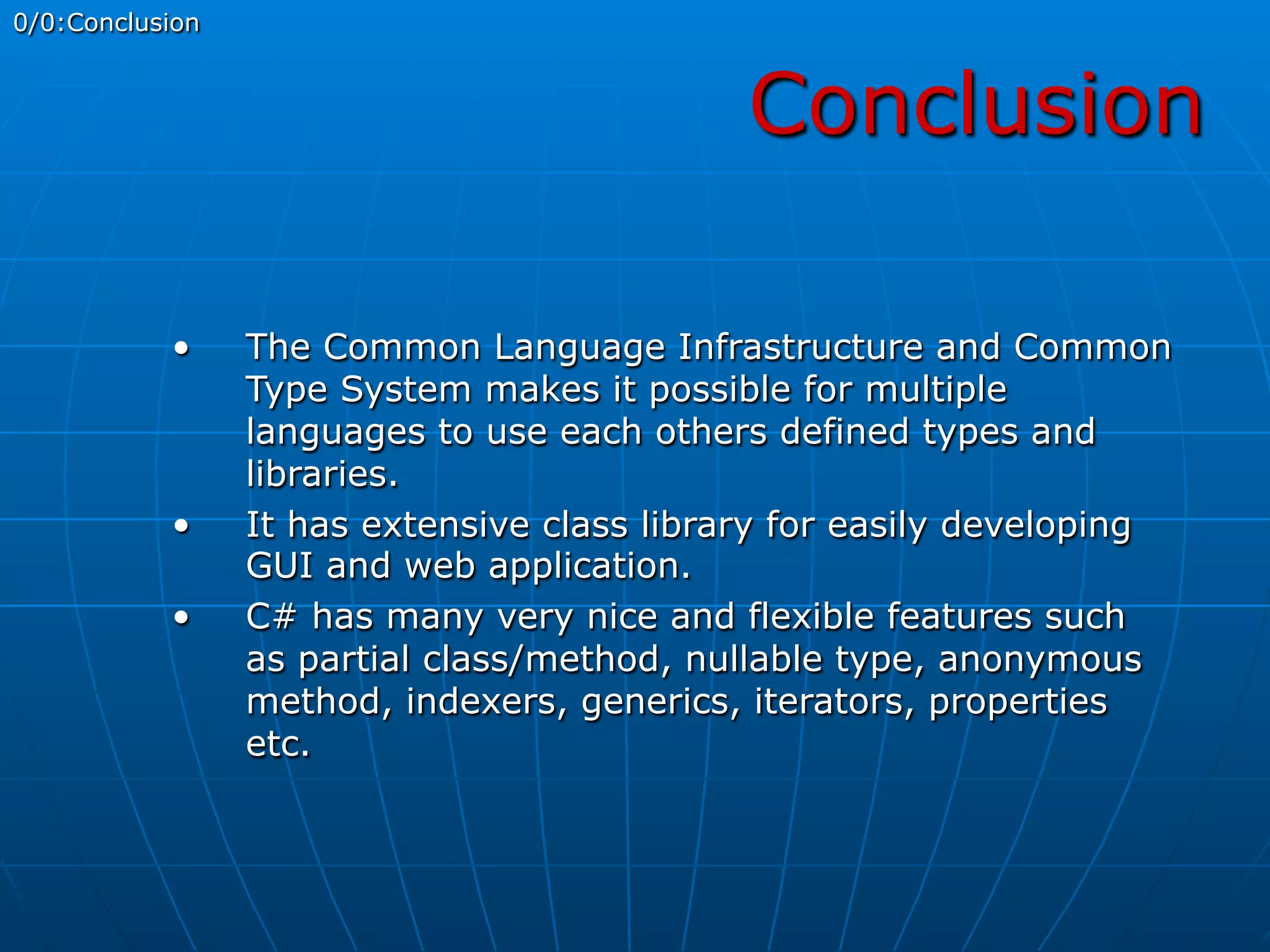This document provides an overview of .NET Framework and C# programming basics. It covers topics such as .NET Framework features like Common Language Runtime and Base Class Library. It also discusses C# language basics, including types like value types and reference types. The document includes code examples demonstrating typical C# programs and features like properties, arrays, and anonymous types.
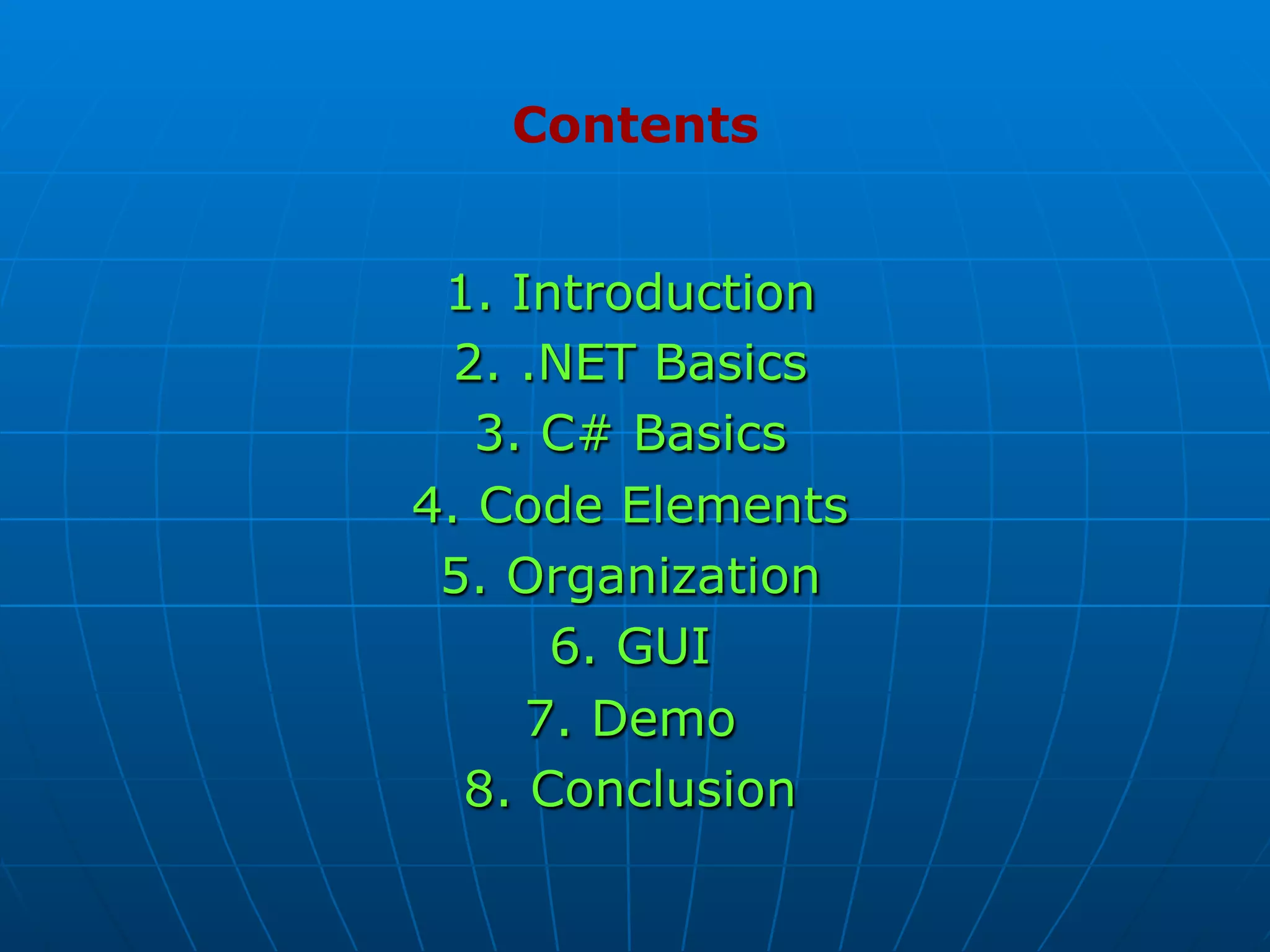
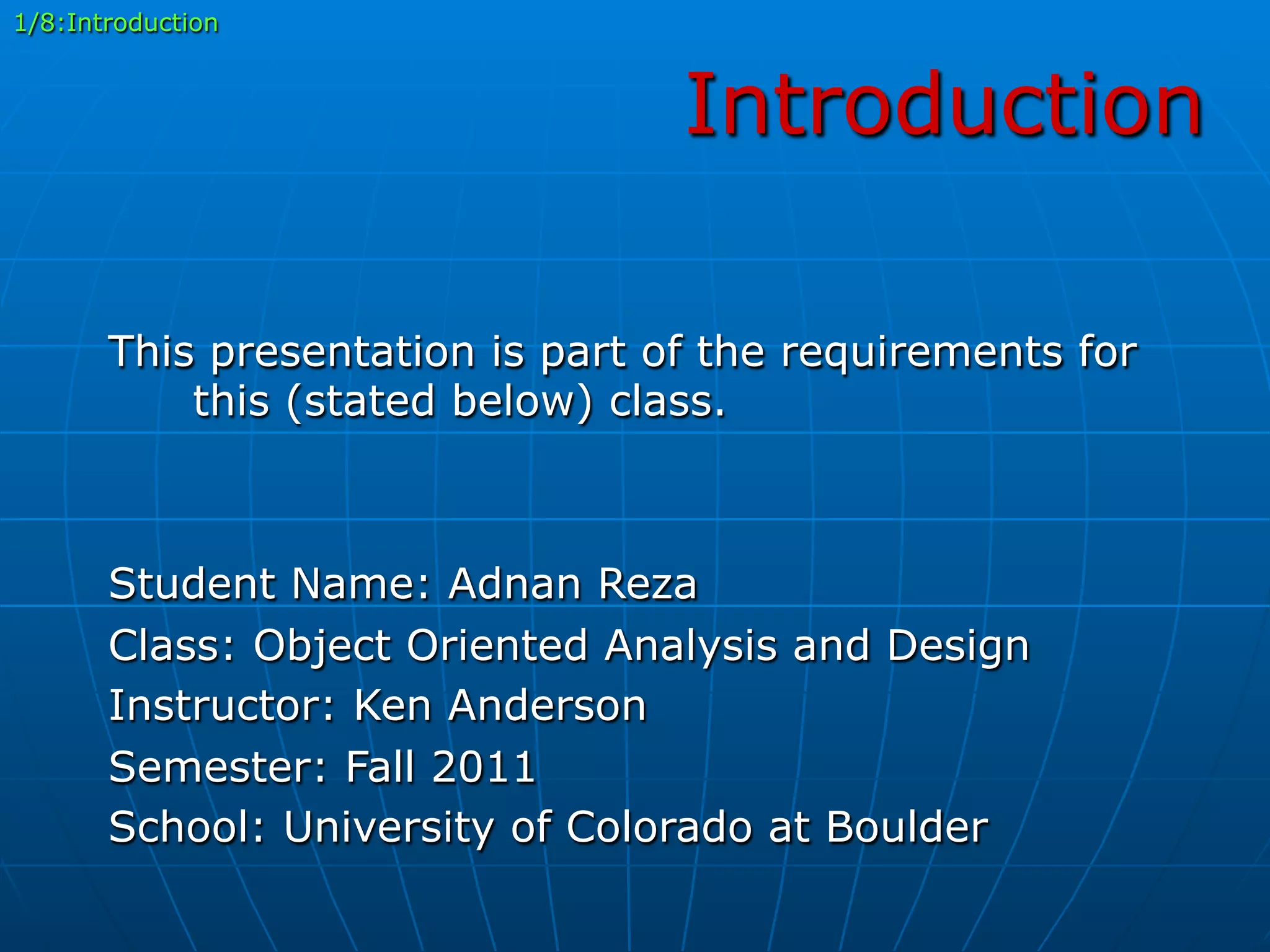
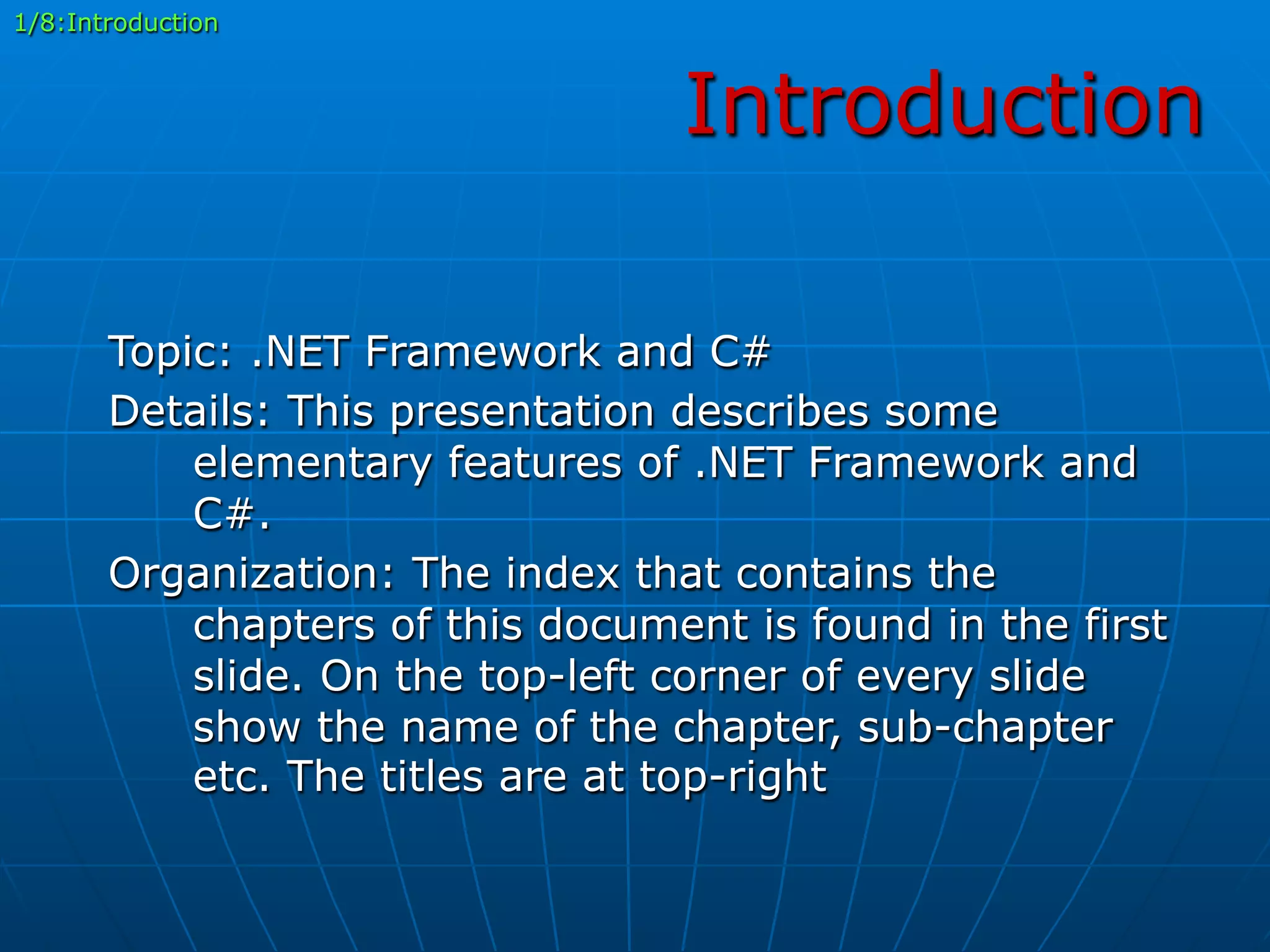
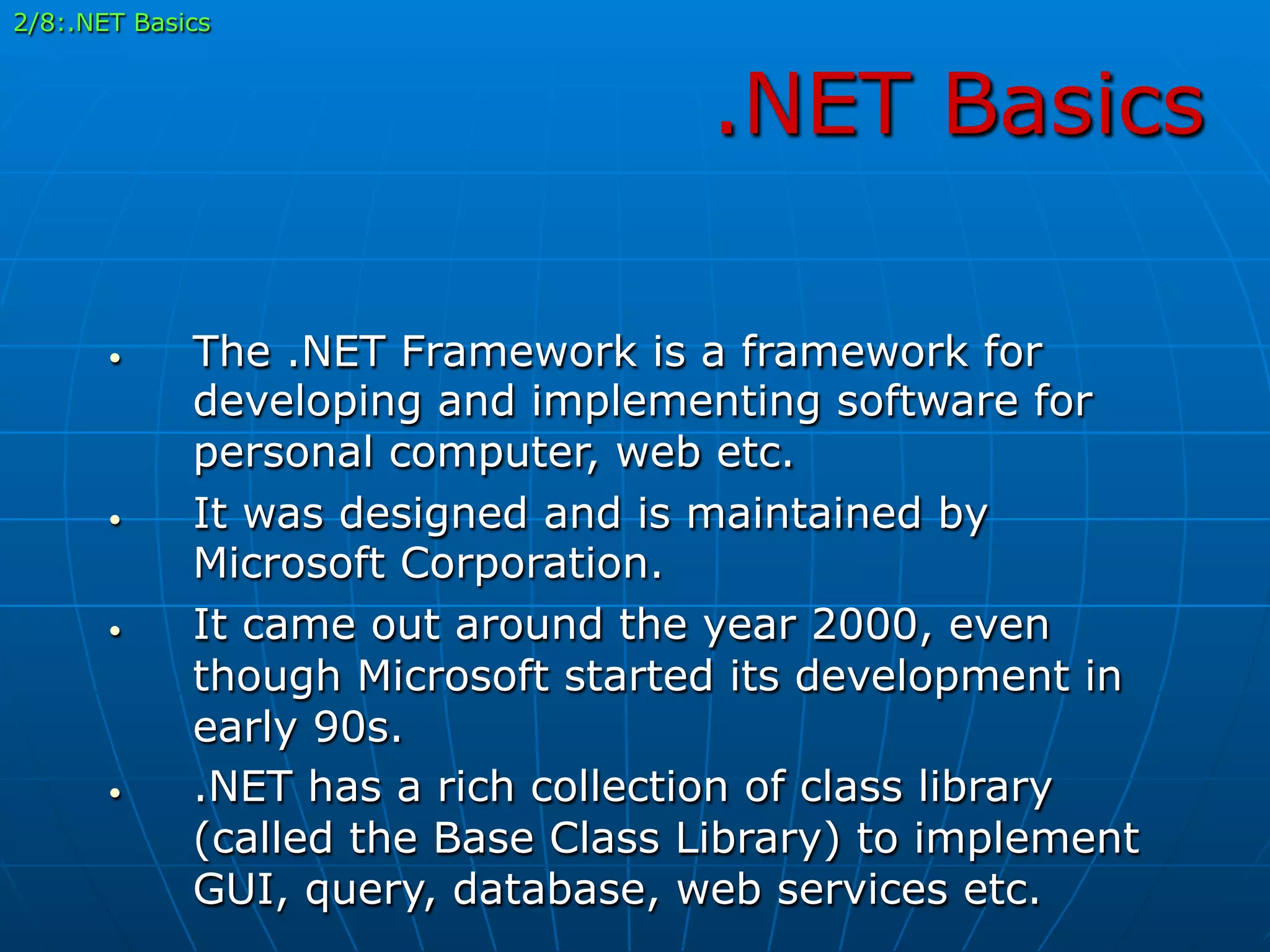
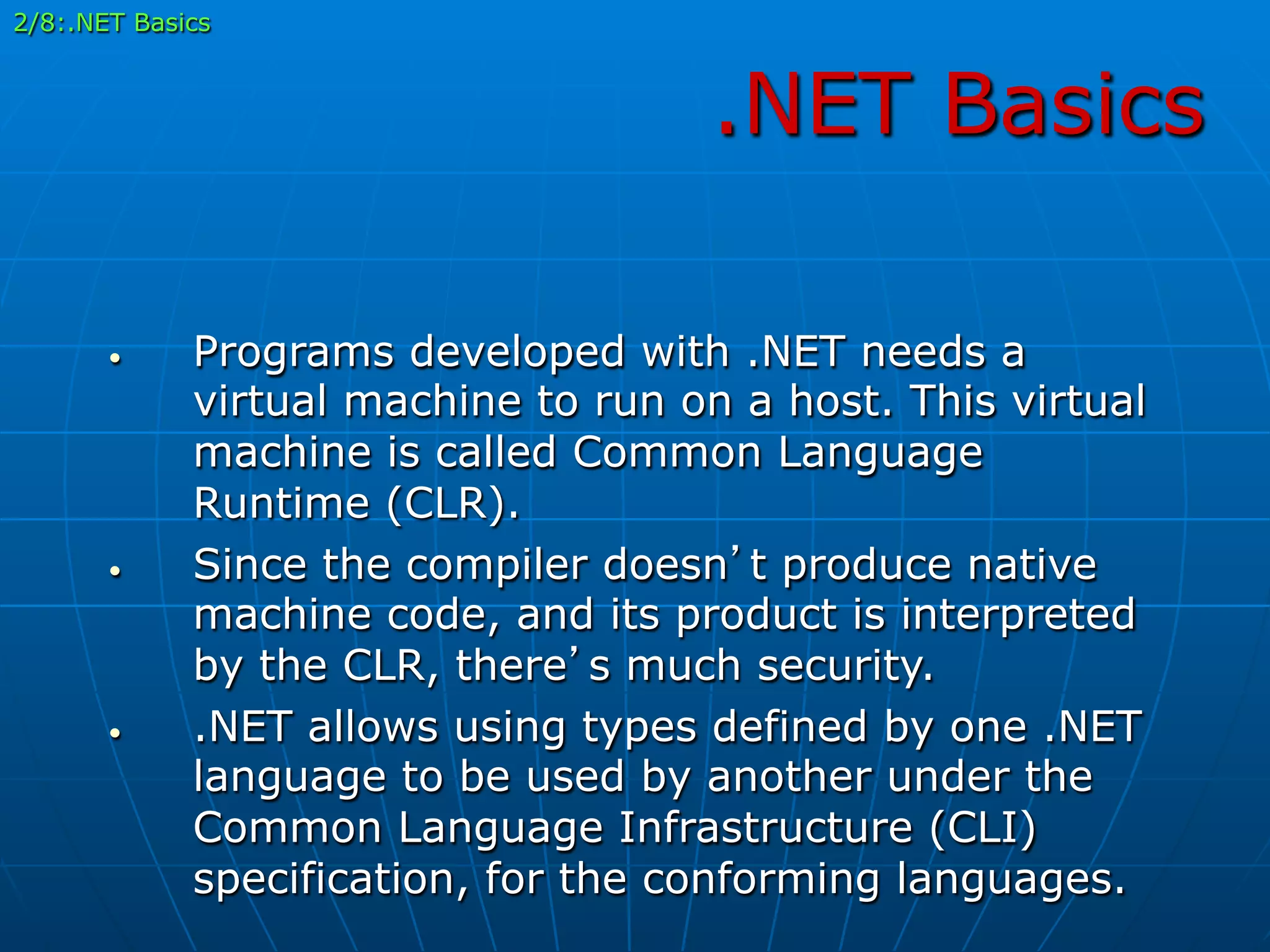
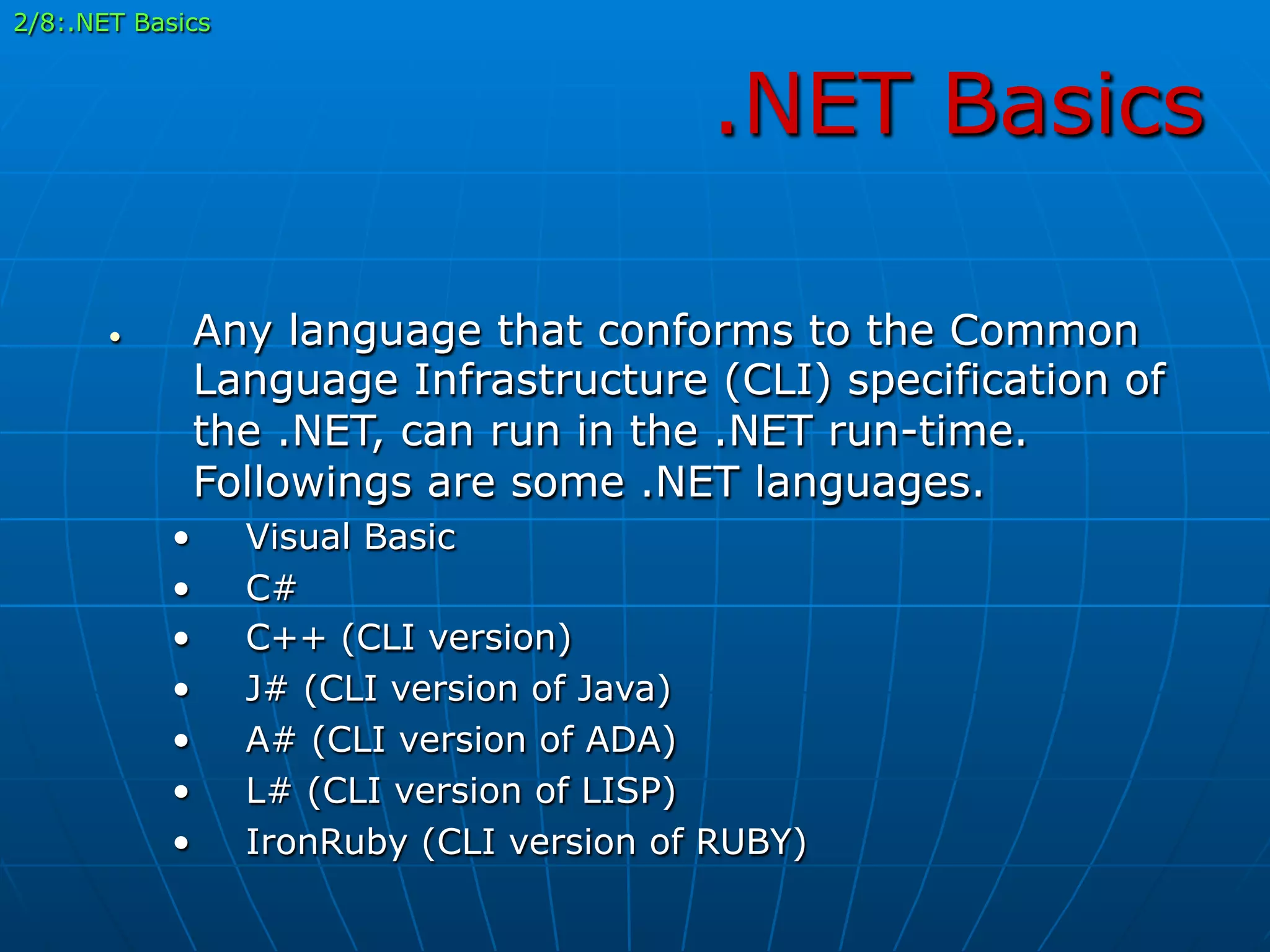
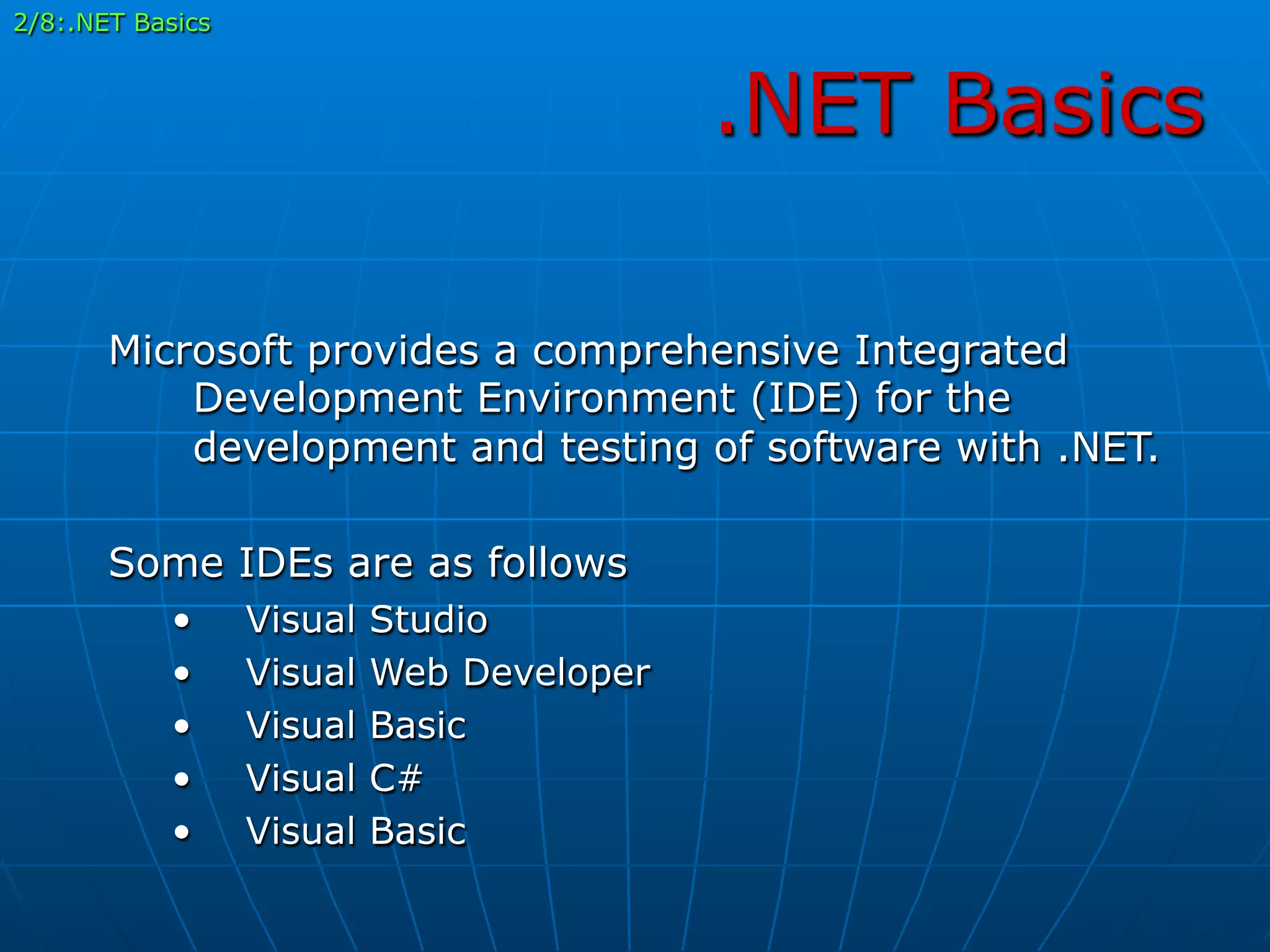
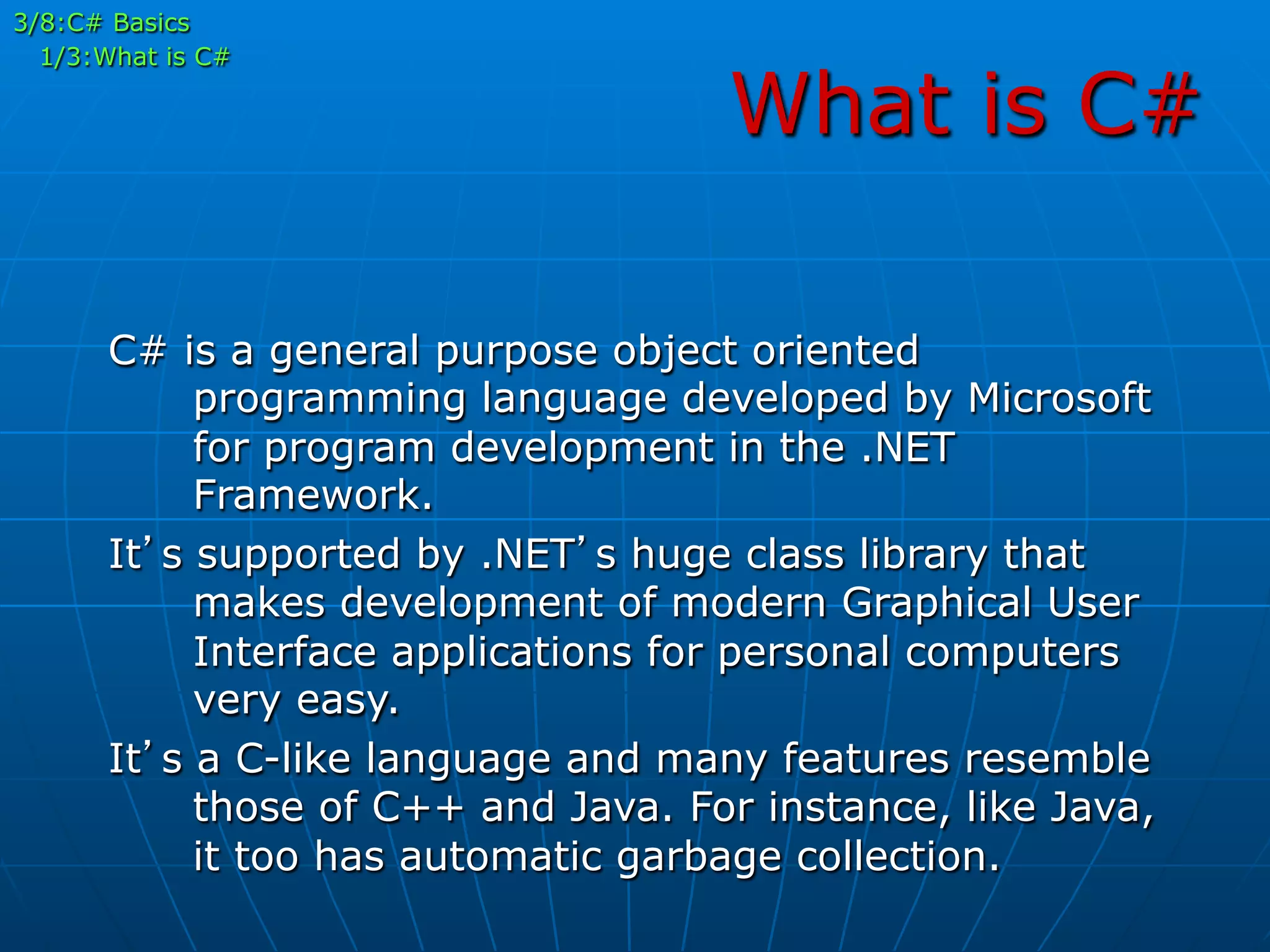
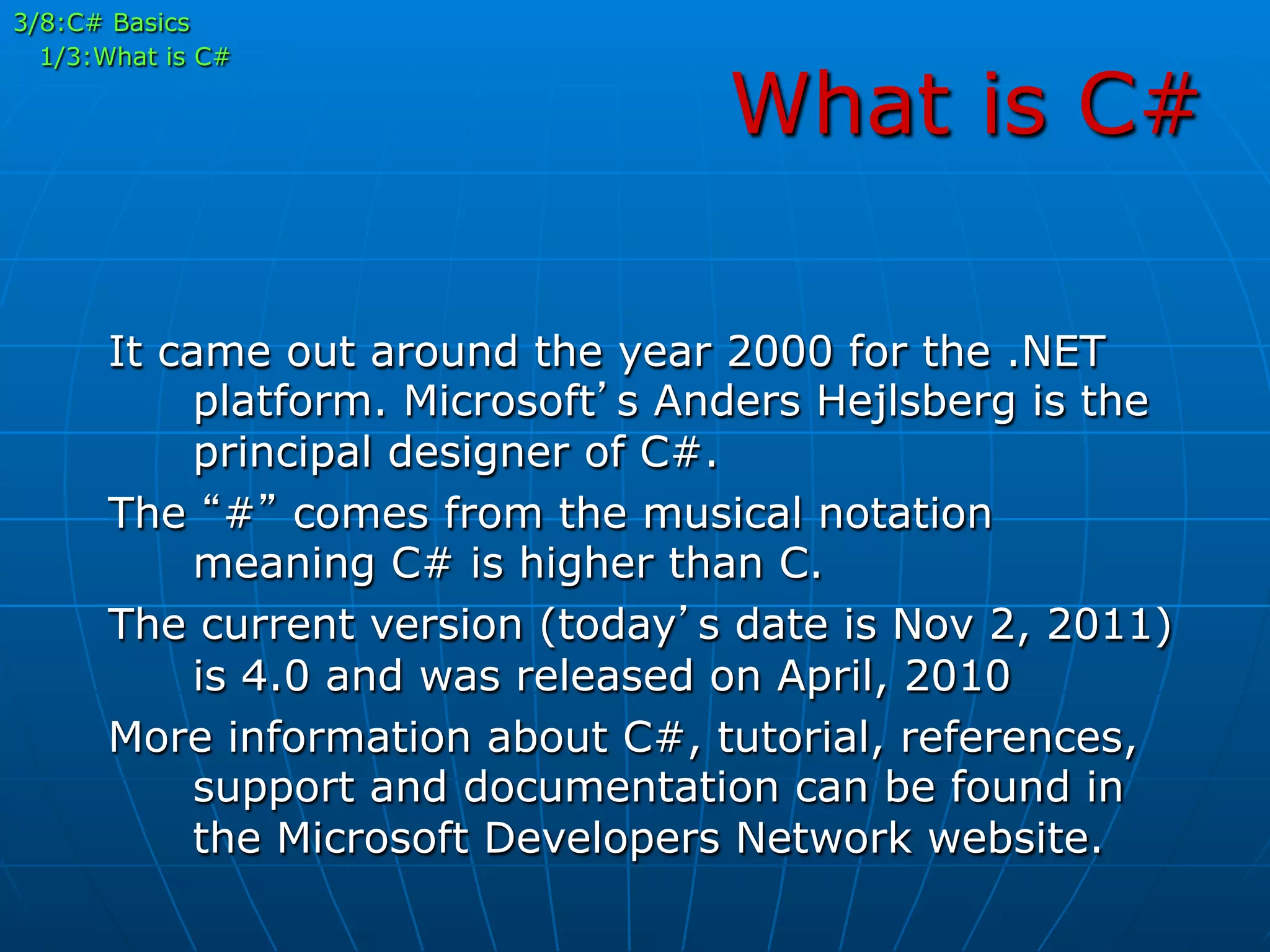
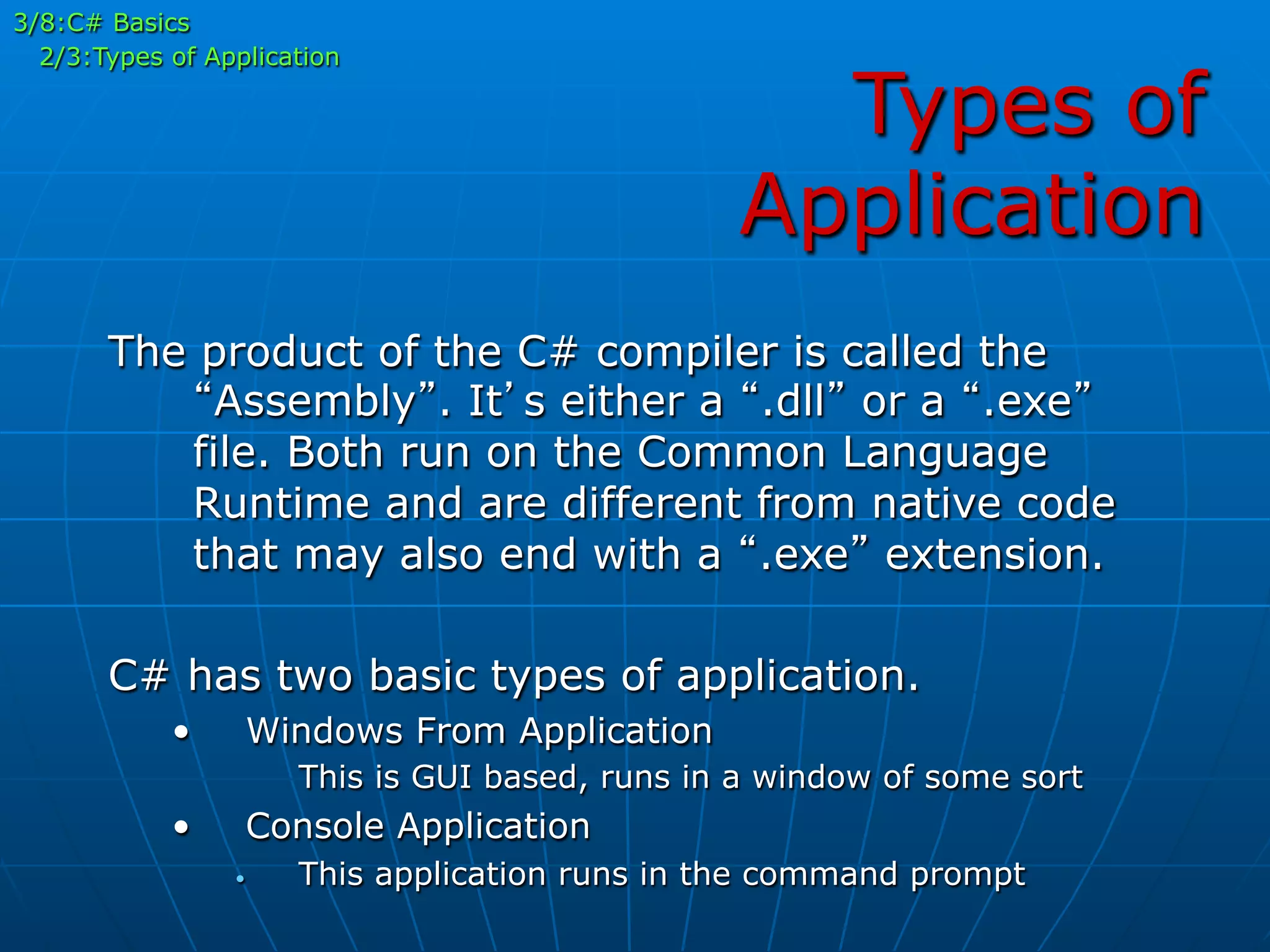
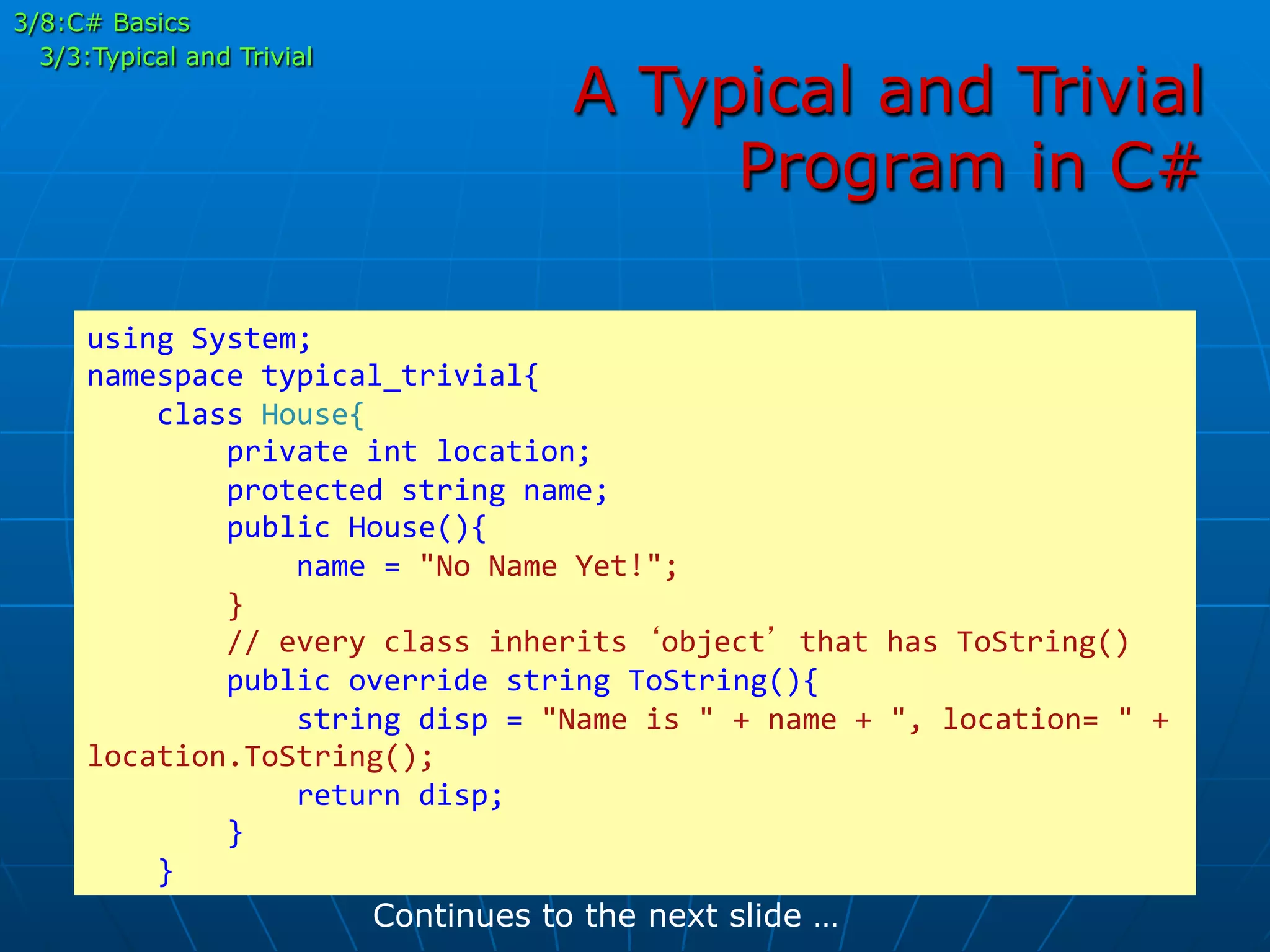
![A Typical and Trivial
Program in C#
class
Program{
static
void
Main(string[]
args){
House
h
=
new
House();
for
(int
i
=
0;
i
<
4;
i++){
System.Console.WriteLine("i={0},
house
says:
{1}",
i,
h.ToString());
}
System.Console.Read();
}
}
}
… continuing from the previous slide
3/8:C# Basics
3/3:Typical and Trivial](https://image.slidesharecdn.com/understandingc-170517115205/75/Understanding-C-in-NET-12-2048.jpg)
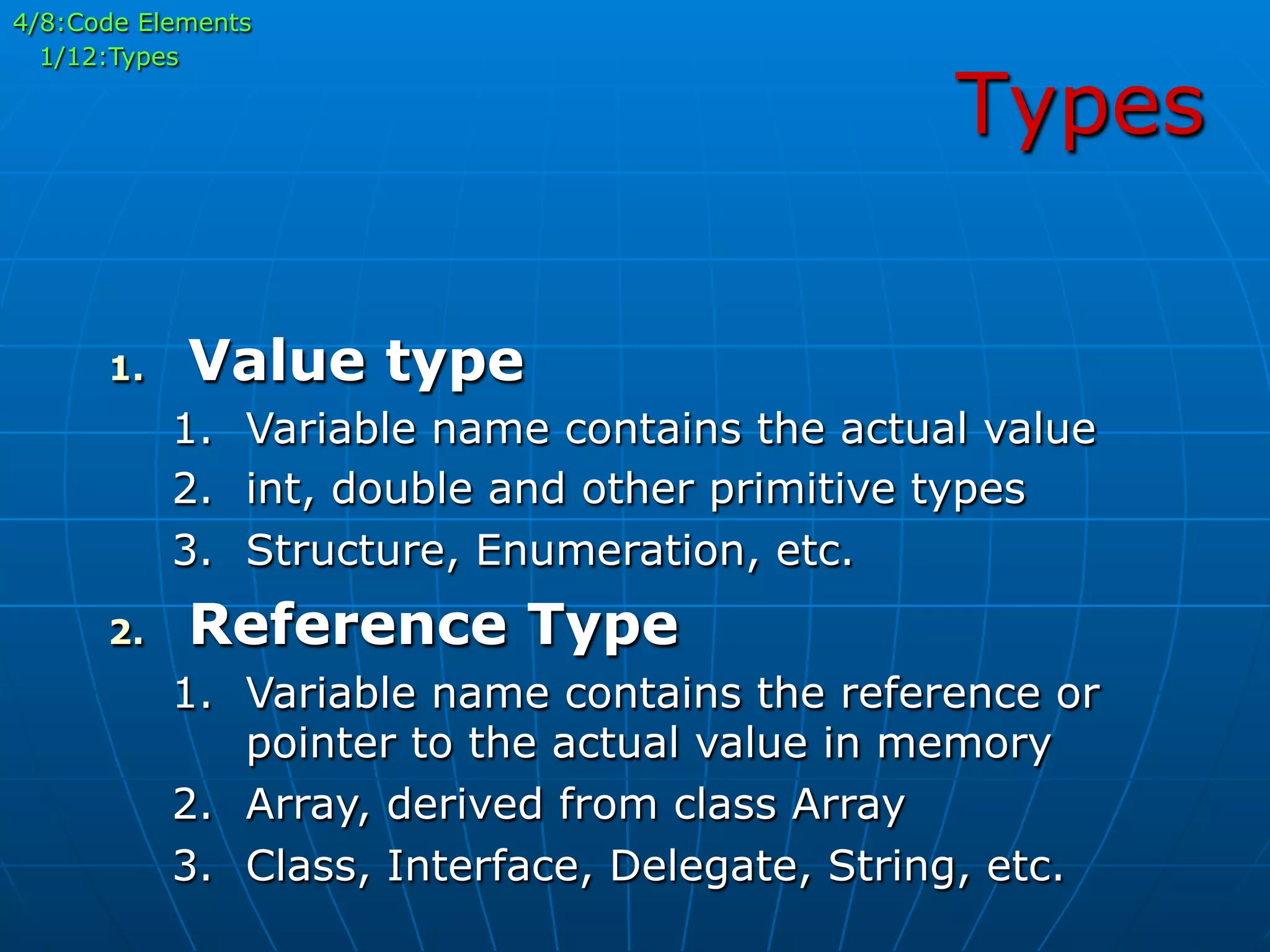
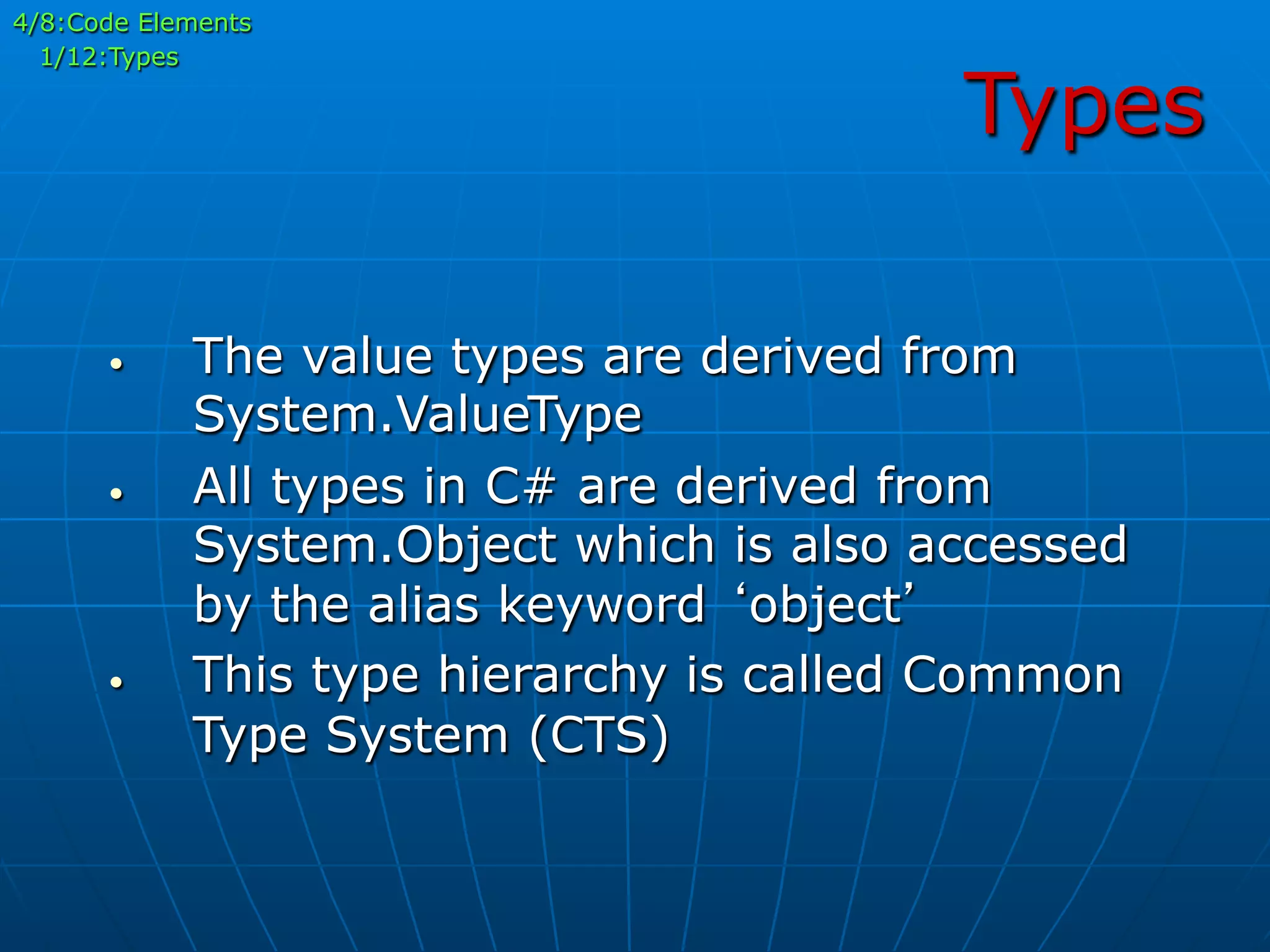
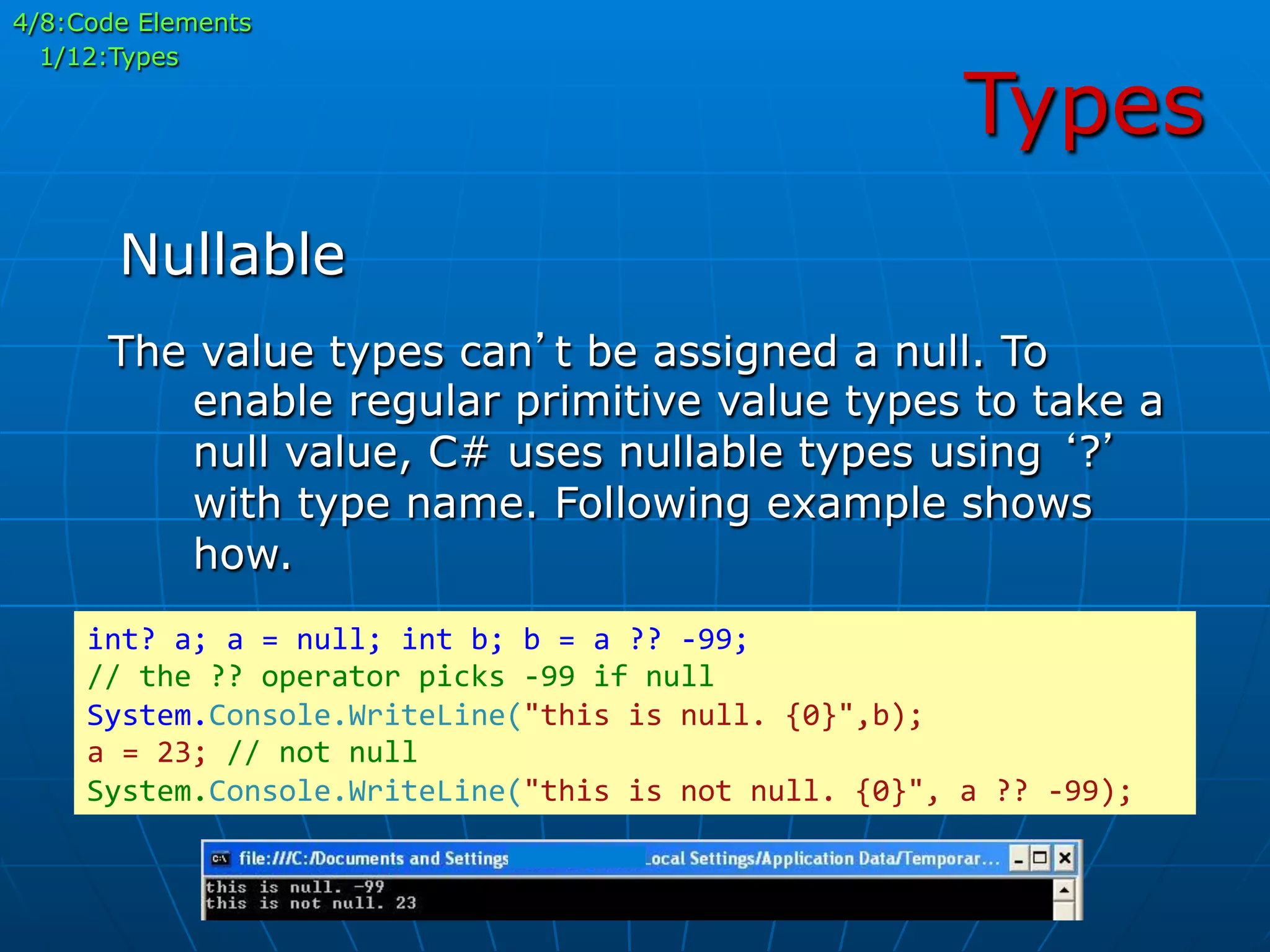
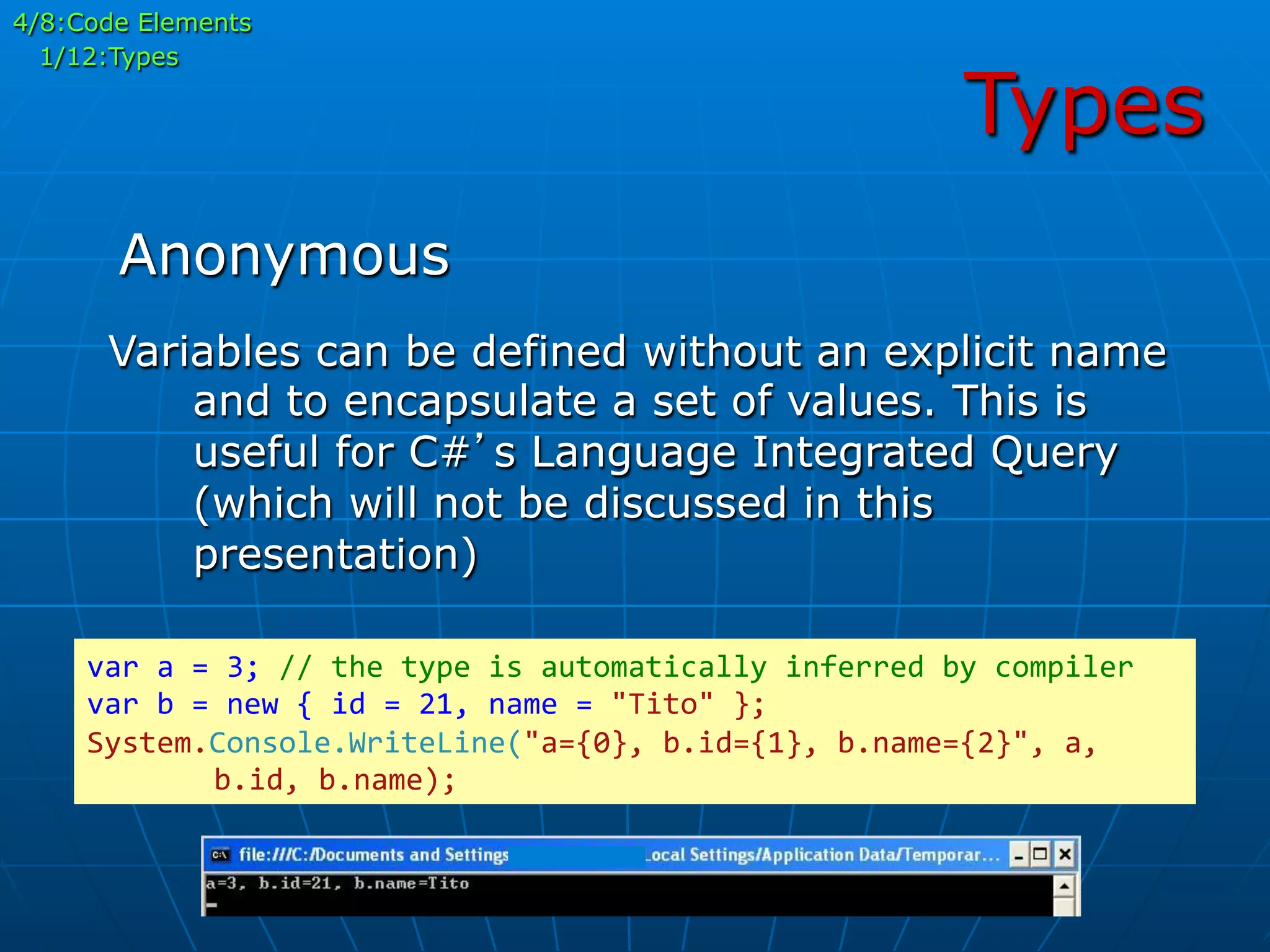
![Arrays
4/8:Code Elements
2/12:Array
Following is an example of declaring and
using a simple array.
int[]
items
=
new
int[]{5,19,41,1,9};
foreach
(int
i
in
items)
{
System.Console.WriteLine("{0}n",
i-‐1);
}](https://image.slidesharecdn.com/understandingc-170517115205/75/Understanding-C-in-NET-17-2048.jpg)
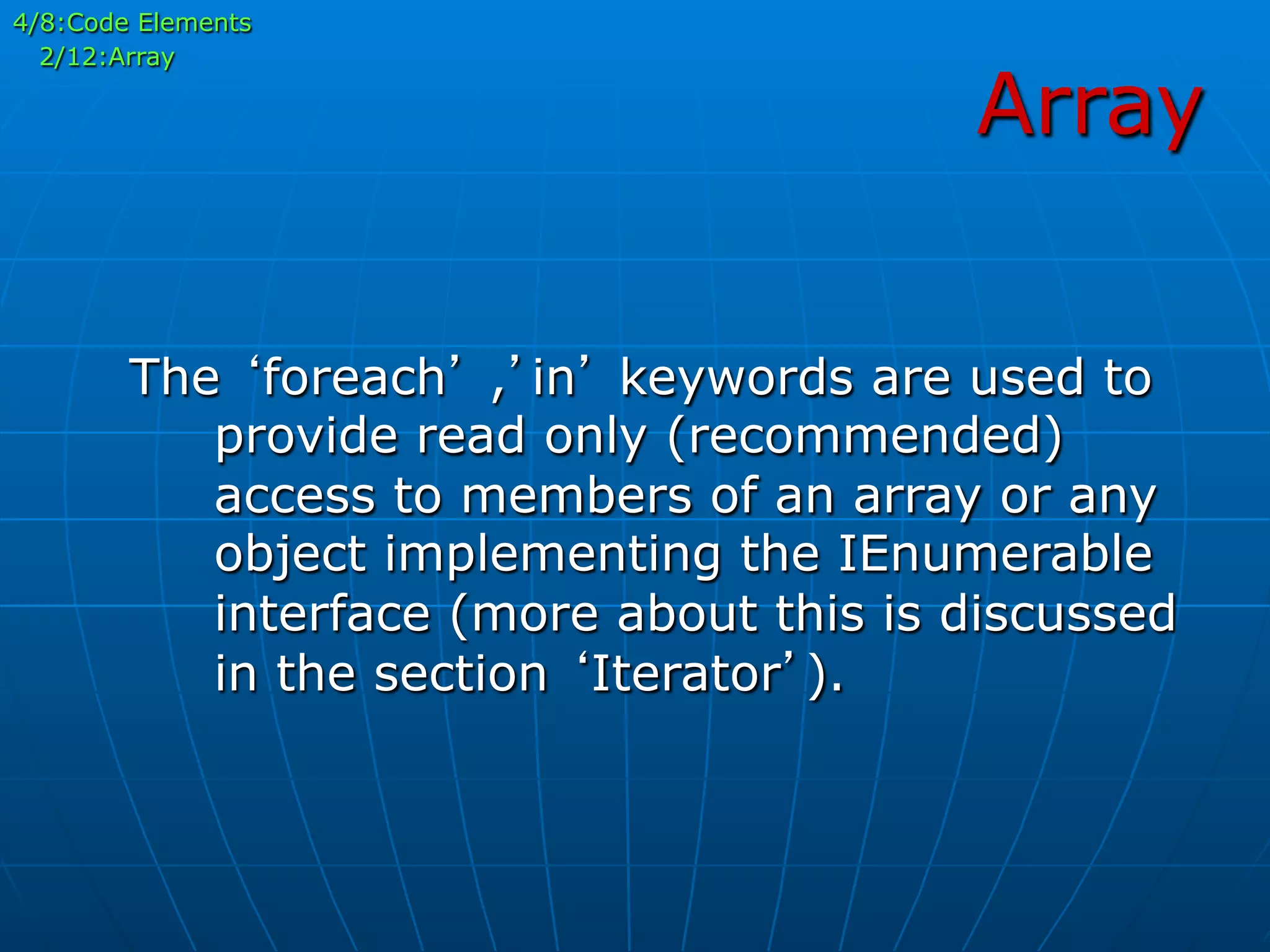
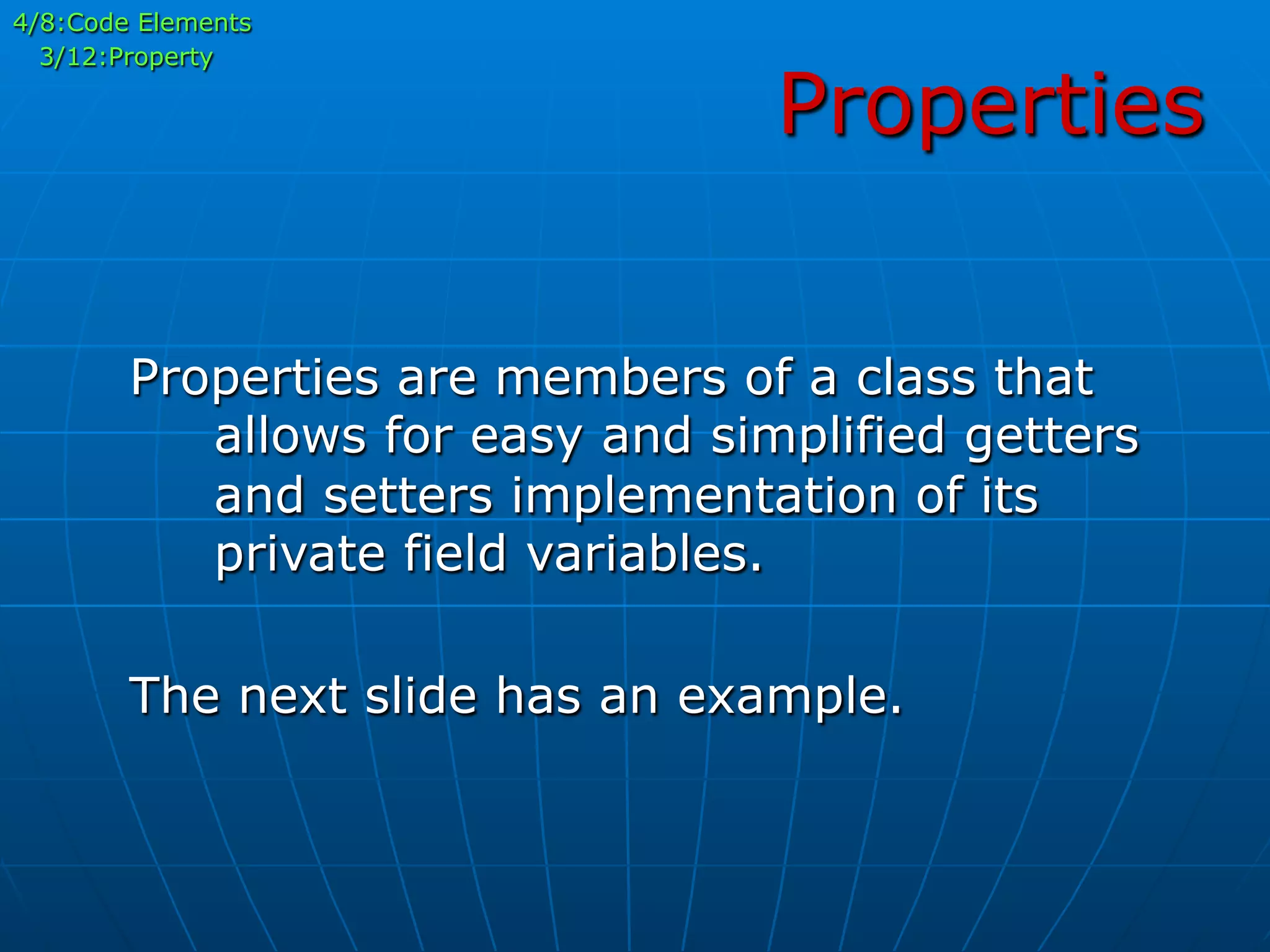
![Properties
class
Client{
private
string
name
;
public
string
Name{
get{
return
name;
}
set{
name=value;
}
}
static
void
Main(string[]
args)
{
Client
c
=
new
Client();
c.Name
=
"Celia";
System.Console.WriteLine(c.Name);
System.Console.ReadLine();
}
}
4/8:Code Elements
3/12:Property](https://image.slidesharecdn.com/understandingc-170517115205/75/Understanding-C-in-NET-20-2048.jpg)
![Properties
class
Client2{
public
string
Name
{
get;
set;
}
static
void
Main(string[]
args){
Client2
c
=
new
Client2();
c.Name
=
"Cruz";
System.Console.WriteLine(c.Name);
System.Console.ReadLine();
}
}
C# also has a feature to automatically implement the getters
and setter for you.
Users have direct access to the data members of the class.
Following example does the same thing as the previous
example, but using automatically implemented properties
Automatically Implemented
4/8:Code Elements
3/12:Property](https://image.slidesharecdn.com/understandingc-170517115205/75/Understanding-C-in-NET-21-2048.jpg)
![Indexers
4/8:Code Elements
4/12:Indexer
Indexers allow a class to be used as an array. For
instance the “[]” operator can be used and the
‘foreach’, ‘in’ keywords can also be used on a
class that has indexers.
The internal representation of the items in that class
are managed by the developer.
Indexers are defined by the following expression.
public int this[int idx]{
get{/* your code*/}; set{/*code here*/};
}](https://image.slidesharecdn.com/understandingc-170517115205/75/Understanding-C-in-NET-22-2048.jpg)
![Nested Classes
4/8:Code Elements
5/12:Nested Class
C# supports nested class which defaults
to private.
class
Program
{
public
class
InsiderClass
{
private
int
a;
}
static
void
Main(string[]
args)
{
}
}](https://image.slidesharecdn.com/understandingc-170517115205/75/Understanding-C-in-NET-23-2048.jpg)
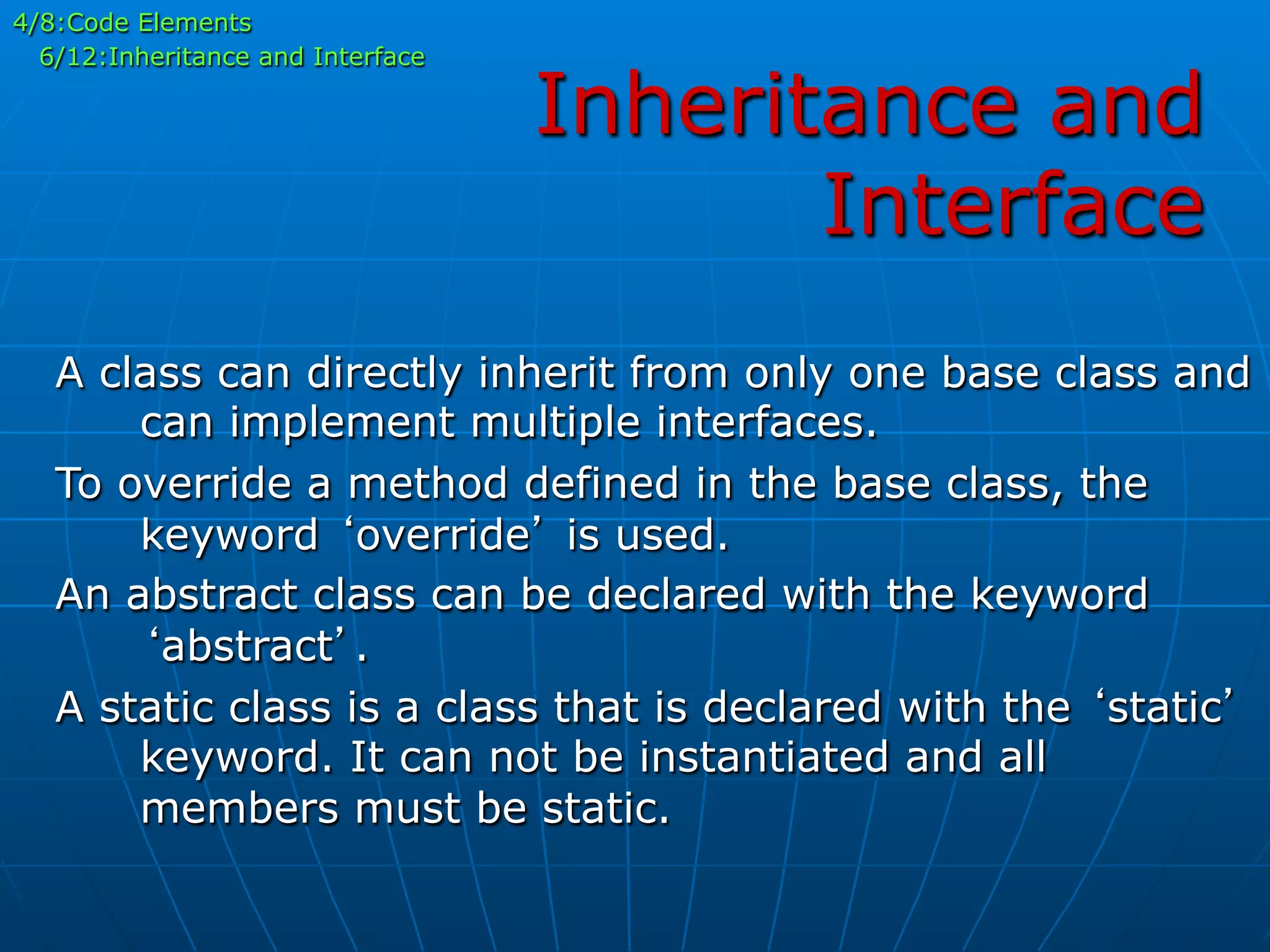
![Inheritance and
Interface
class
BaseClass{
public
virtual
void
show(){
System.Console.WriteLine("base
class");}
}
interface
Interface1{void
showMe();}
interface
Interface2{void
showYou();}
class
DerivedAndImplemented:
BaseClass,Interface1,Interface2{
public
void
showMe()
{
System.Console.WriteLine("Me!");
}
public
void
showYou()
{
System.Console.WriteLine("You!");
}
public
override
void
show(){
System.Console.WriteLine("I'm
in
derived
Class");}
static
void
Main(string[]
args){
DerivedAndImplemented
de
=
new
DerivedAndImplemented();
de.show();
System.Console.Read();}
}
4/8:Code Elements
6/12:Inheritance and Interface](https://image.slidesharecdn.com/understandingc-170517115205/75/Understanding-C-in-NET-25-2048.jpg)
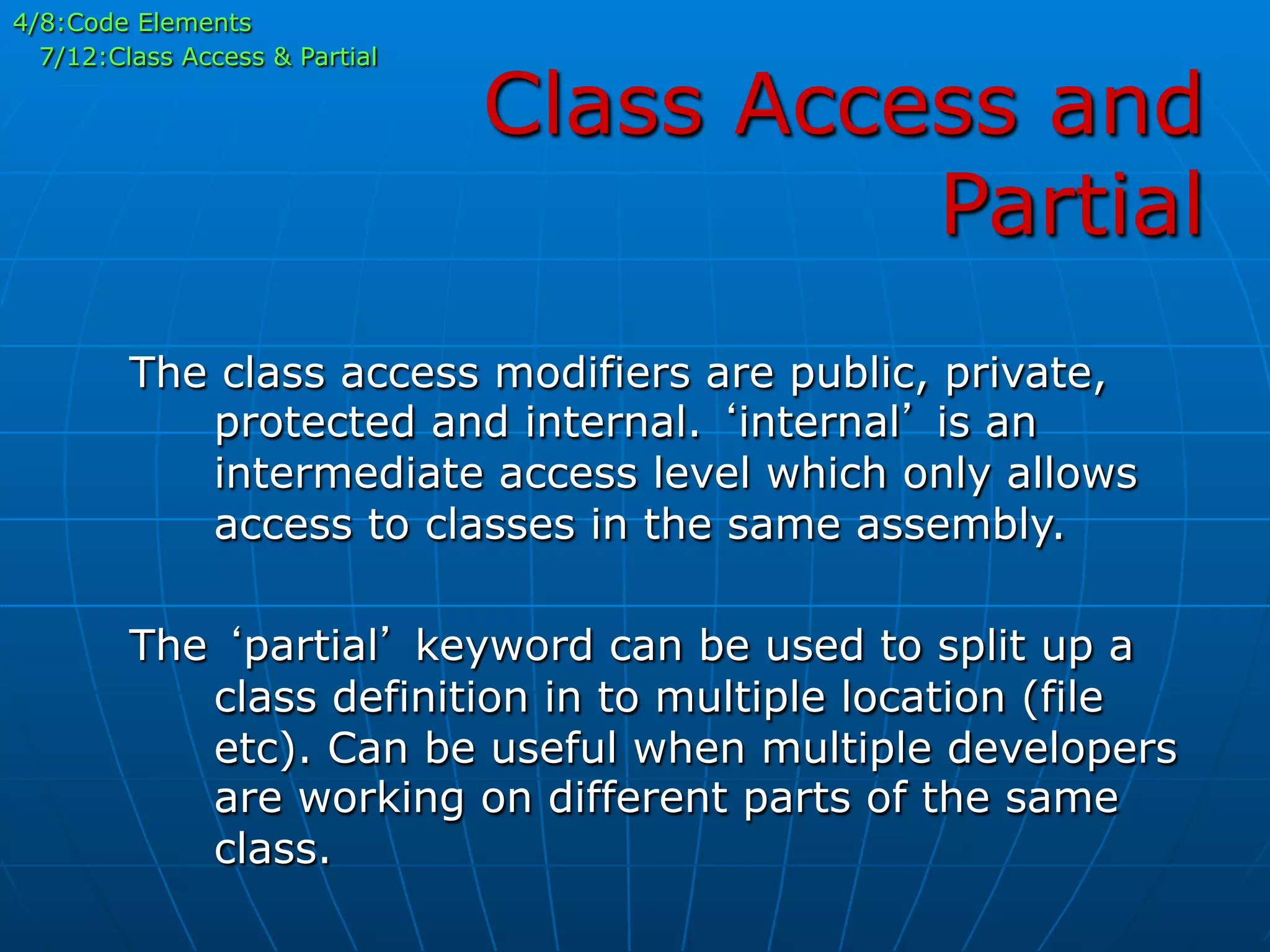
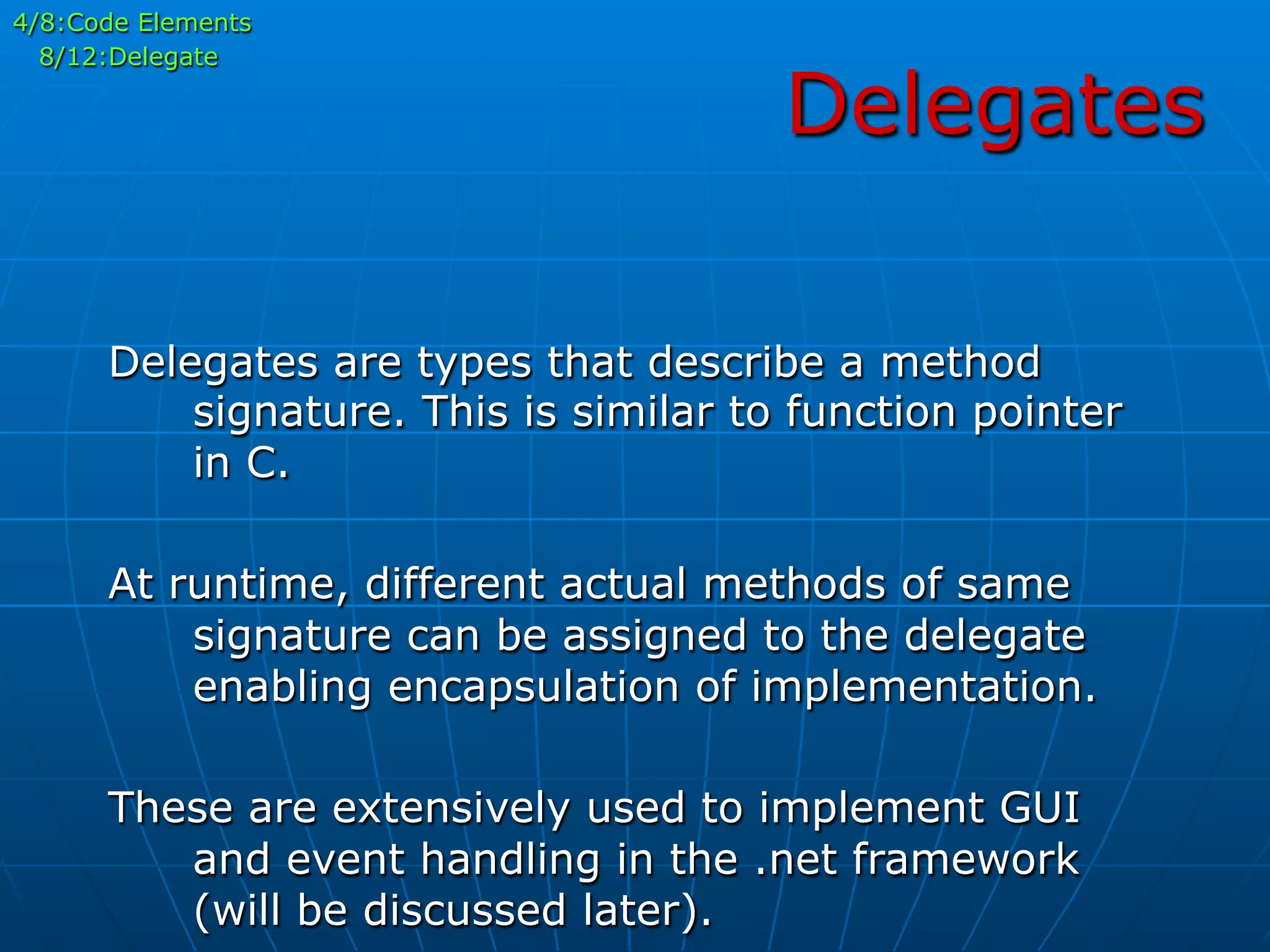
![Delegates
class
Program
{
delegate
int
mydel(int
aa);
int
myfunc(int
a){
return
a*a;
}
int
myfunc2(int
a)
{
return
a
+
a;
}
static
void
Main(string[]
args)
{
Program
p=new
Program();
mydel
d=p.myfunc;
System.Console.WriteLine(d(5));
d
=
p.myfunc2;
System.Console.WriteLine(d(5));
System.Console.Read();
}
}
4/8:Code Elements
8/12:Delegate](https://image.slidesharecdn.com/understandingc-170517115205/75/Understanding-C-in-NET-28-2048.jpg)
![Delegates
In C#, implementors (functions) that are targeted by a
delegate, can be created anonymously, inline and on
the fly by using the lambda operator “=>”.
Lambda Expression
class
Program
{
delegate
int
mydel(int
aa,
int
bb);
static
void
Main(string[]
args)
{
mydel
d
=
(a,
b)
=>
a
+
2
*
b;
//
in
above
line,
read
a,b
go
to
a+b*2
to
evaluate
System.Console.WriteLine(d(2,3));
System.Console.Read();
}
}
4/8:Code Elements
8/12:Delegate](https://image.slidesharecdn.com/understandingc-170517115205/75/Understanding-C-in-NET-29-2048.jpg)
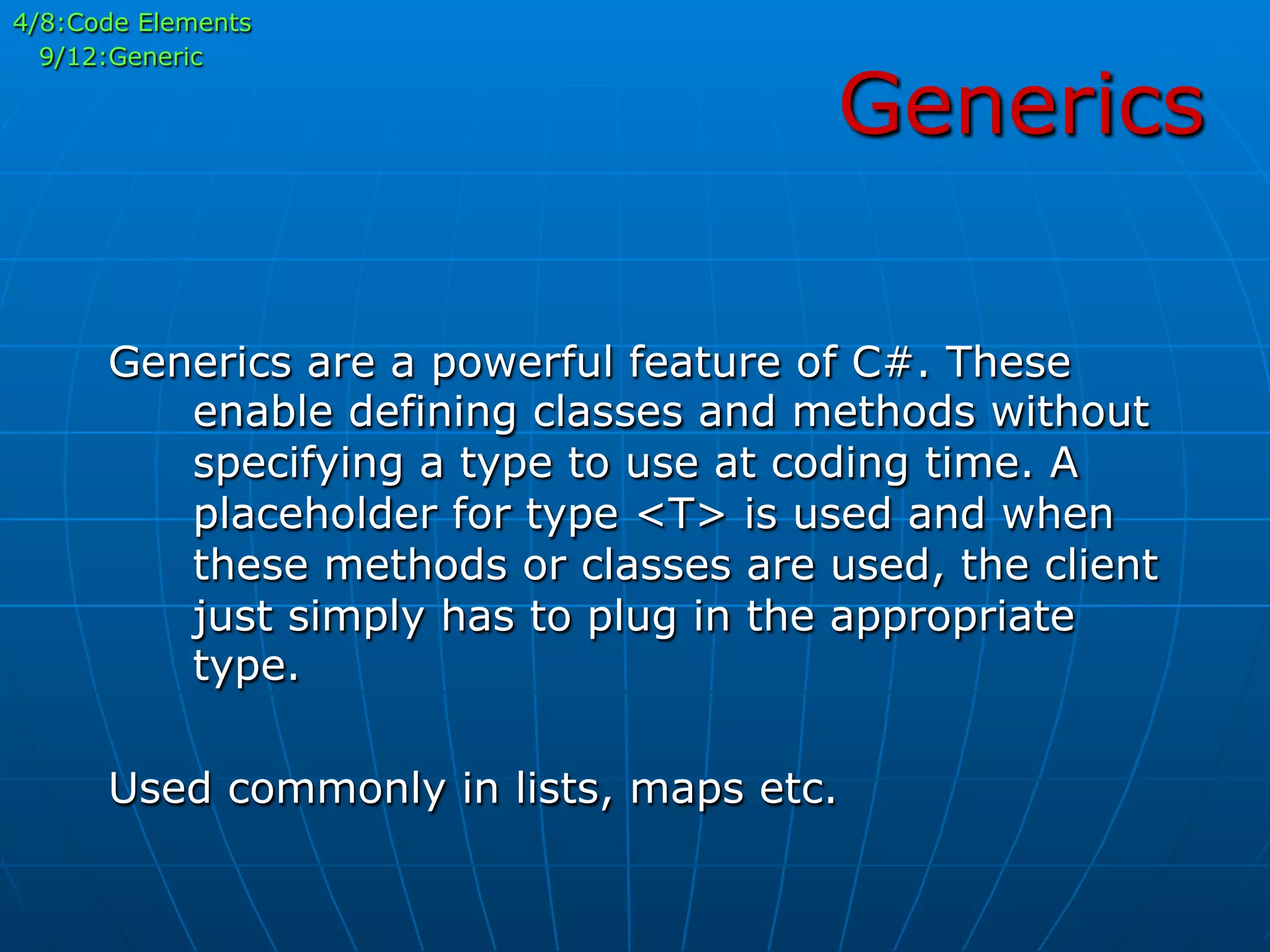
![Generics
class
Genclass<T>{
public
void
genfunc(int
a,
T
b){
for
(int
i
=
0;
i
<
a;
i++){
System.Console.WriteLine(b);
}
}
}
class
Program{
static
void
Main(string[]
args){
Genclass<float>
p
=
new
Genclass<float>();
p.genfunc(3,(float)5.7);
System.Console.Read();
}
}
4/8:Code Elements
9/12:Generic](https://image.slidesharecdn.com/understandingc-170517115205/75/Understanding-C-in-NET-31-2048.jpg)
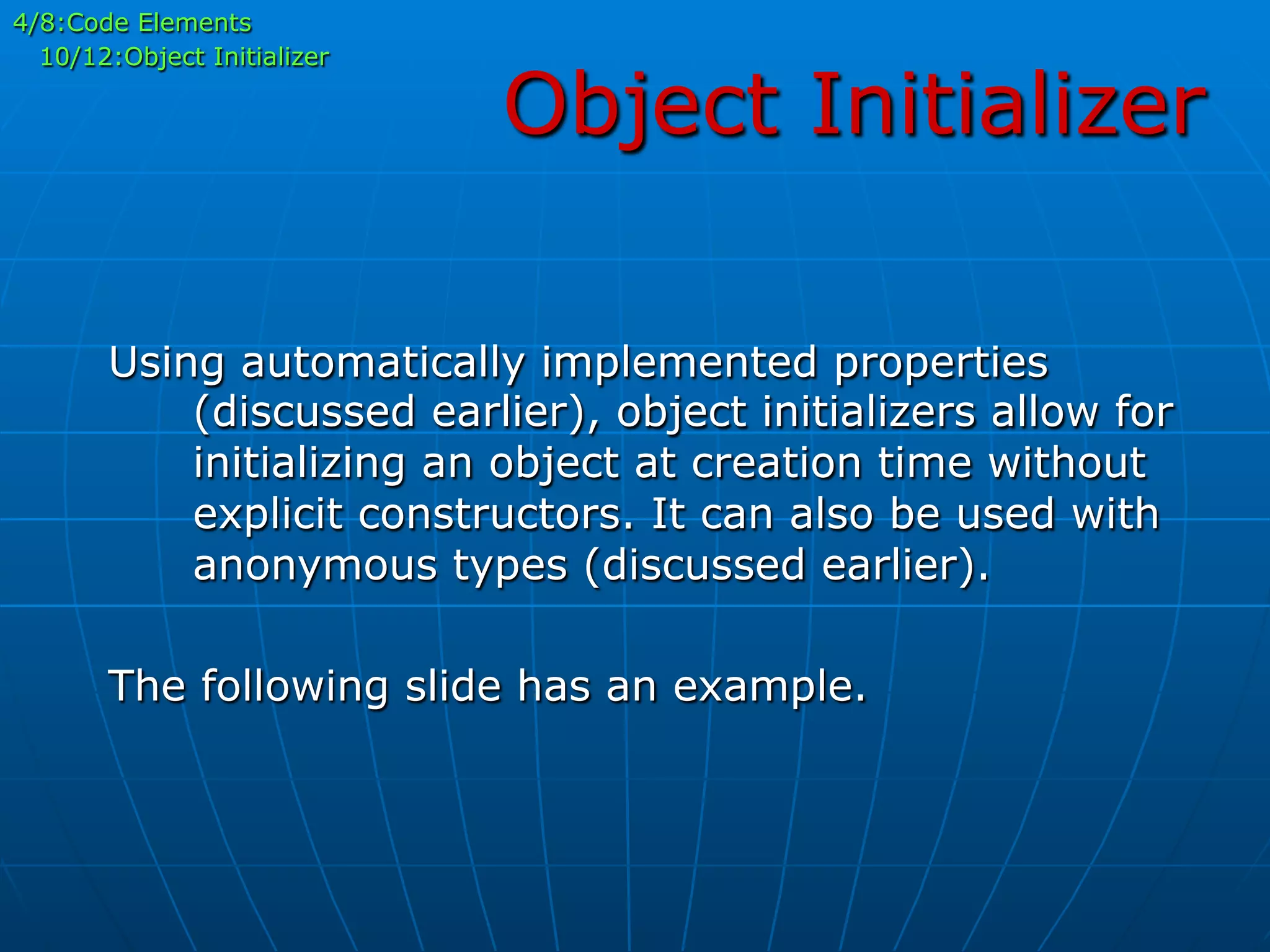
![Object Initializer
class
Client2
{
public
string
Name
{
get;
set;
}
static
void
Main(string[]
args)
{
Client2
c
=
new
Client2
{Name="Adalbarto"};
//
above
is
the
object
initializer
System.Console.WriteLine(c.Name);
System.Console.ReadLine();
}
}
4/8:Code Elements
10/12:Object Initializer](https://image.slidesharecdn.com/understandingc-170517115205/75/Understanding-C-in-NET-33-2048.jpg)
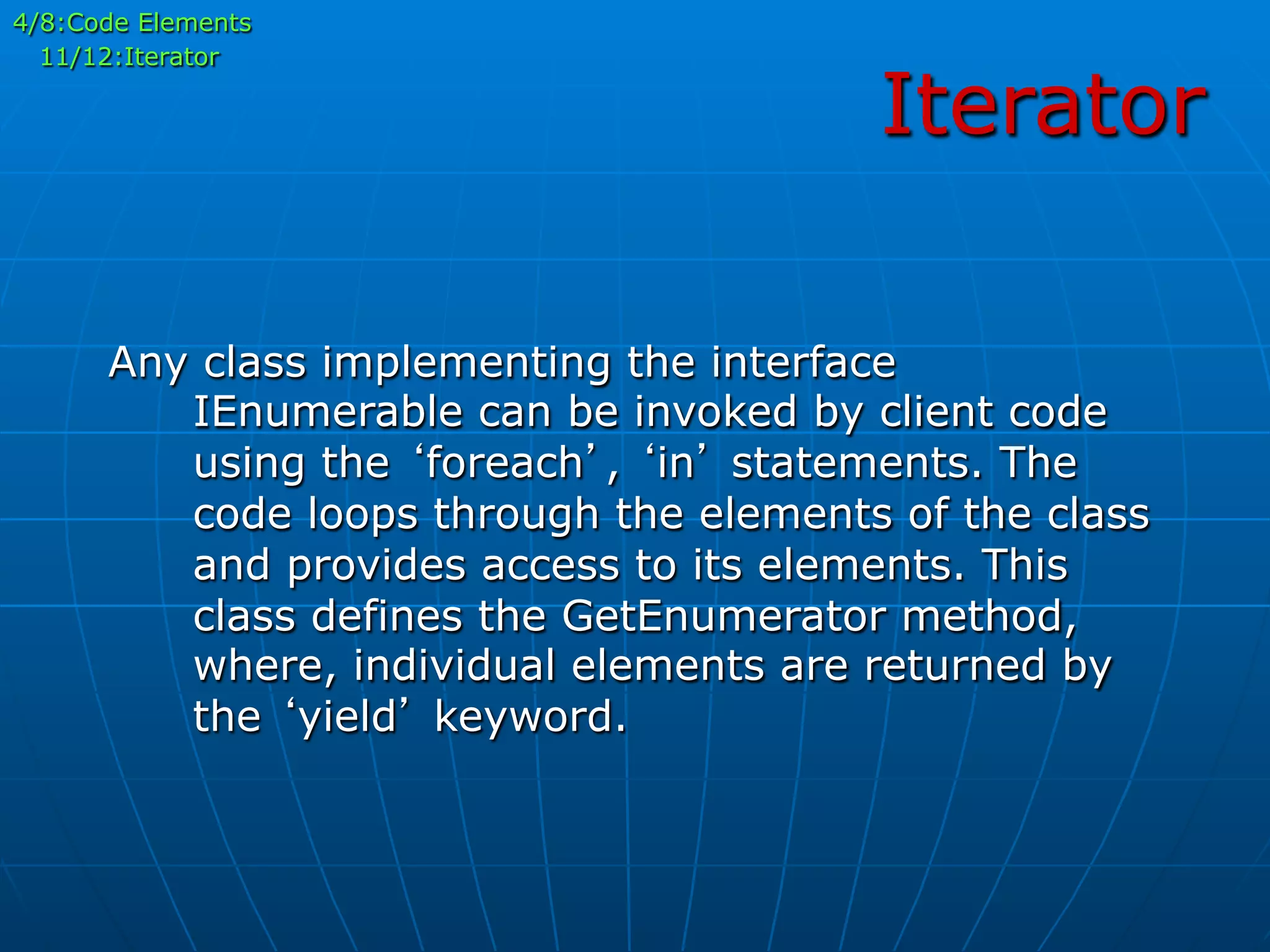
![Iterator
public
class
MyBooks
:
System.Collections.IEnumerable
{
string[]
books
=
{
"Linear
Systems",
"Design
Patterns
Explained",
"The
Now
Habbit",
"The
DeVinci
Code"
};
public
System.Collections.IEnumerator
GetEnumerator()
{
for
(int
i
=
0;
i
<
books.Length;
i++)
{
yield
return
books[i];
}
}
}
class
Program
{
static
void
Main(string[]
args)
{
MyBooks
b
=
new
MyBooks();
foreach
(string
s
in
b)
{
System.Console.Write(s
+
"
");
}
System.Console.Read();
}
}
4/8:Code Elements
11/12:Iterator](https://image.slidesharecdn.com/understandingc-170517115205/75/Understanding-C-in-NET-35-2048.jpg)
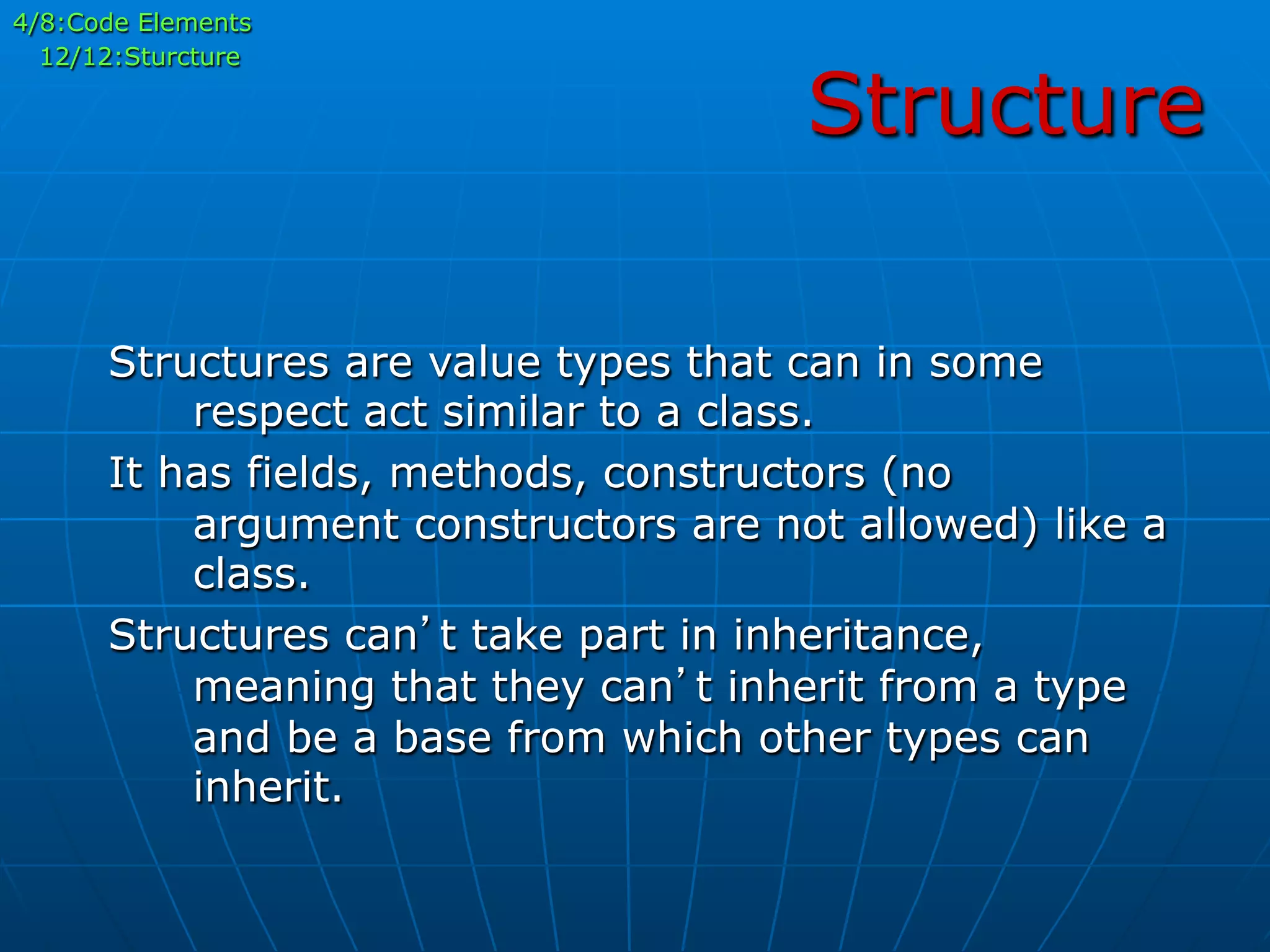
![Structure
struct
Rectangle{
public
int
length;
public
int
width;
public
Rectangle(int
length,int
width){
this.length=length;
this.width=width;
}
public
int
getArea(){
return
length*width;
}
}
class
Program{
static
void
Main(string[]
args){
Rectangle
r=new
Rectangle(2,5);
System.Console.WriteLine("The
area
is:
{0}",r.getArea());
System.Console.Read();
}
}
4/8:Code Elements
12/12:Sturcture](https://image.slidesharecdn.com/understandingc-170517115205/75/Understanding-C-in-NET-37-2048.jpg)
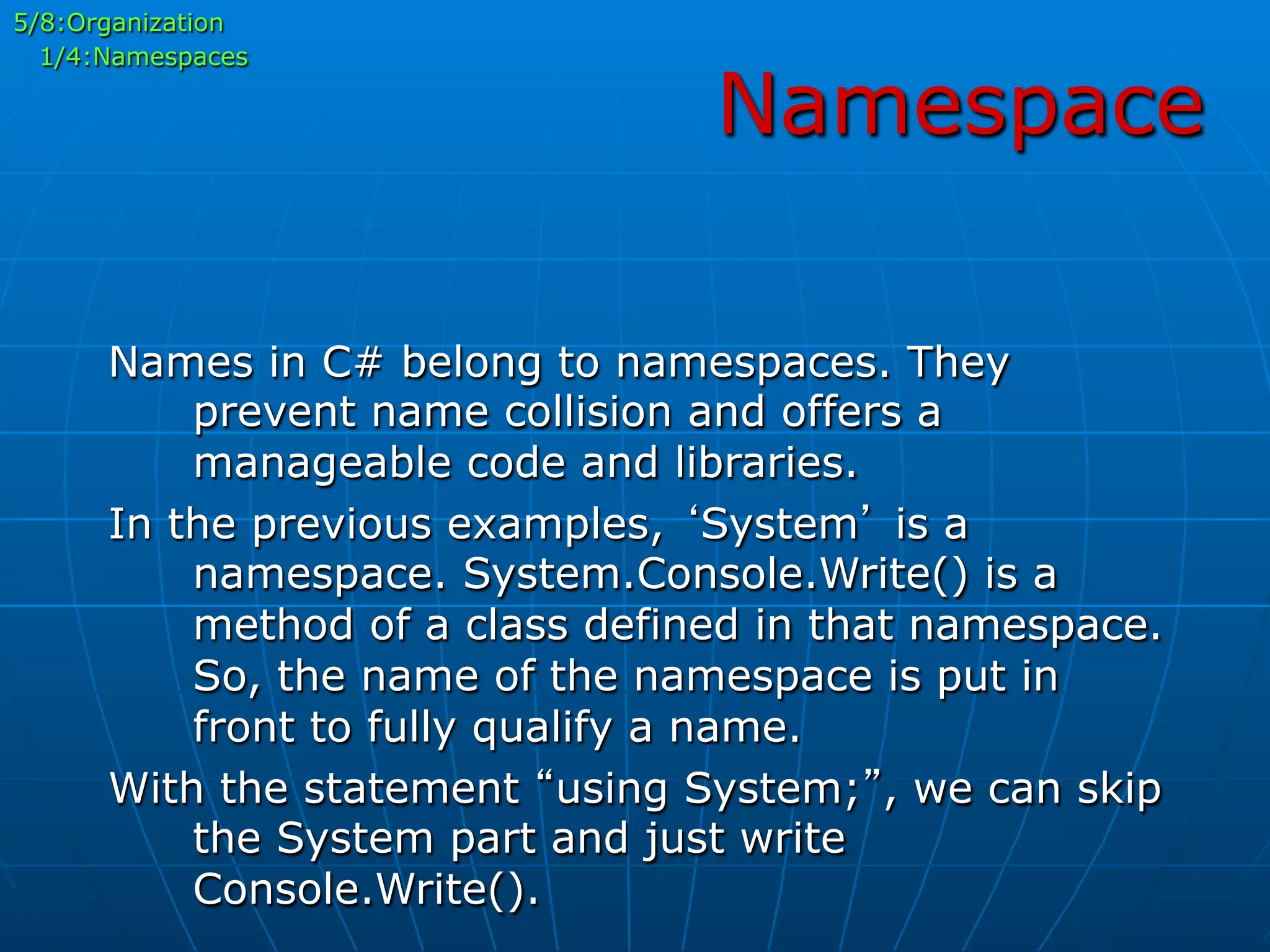
![Namespace
using
System;
namespace
space1{
class
MyClass1{
public
void
show(){
System.Console.WriteLine("MyClass1");
}
}
}
namespace
space2{
class
Program{
static
void
Main(string[]
args){
space1.MyClass1
c=new
space1.MyClass1();
c.show();
Console.Read();
}
}
}
5/8:Organization
1/4:Namespaces](https://image.slidesharecdn.com/understandingc-170517115205/75/Understanding-C-in-NET-39-2048.jpg)
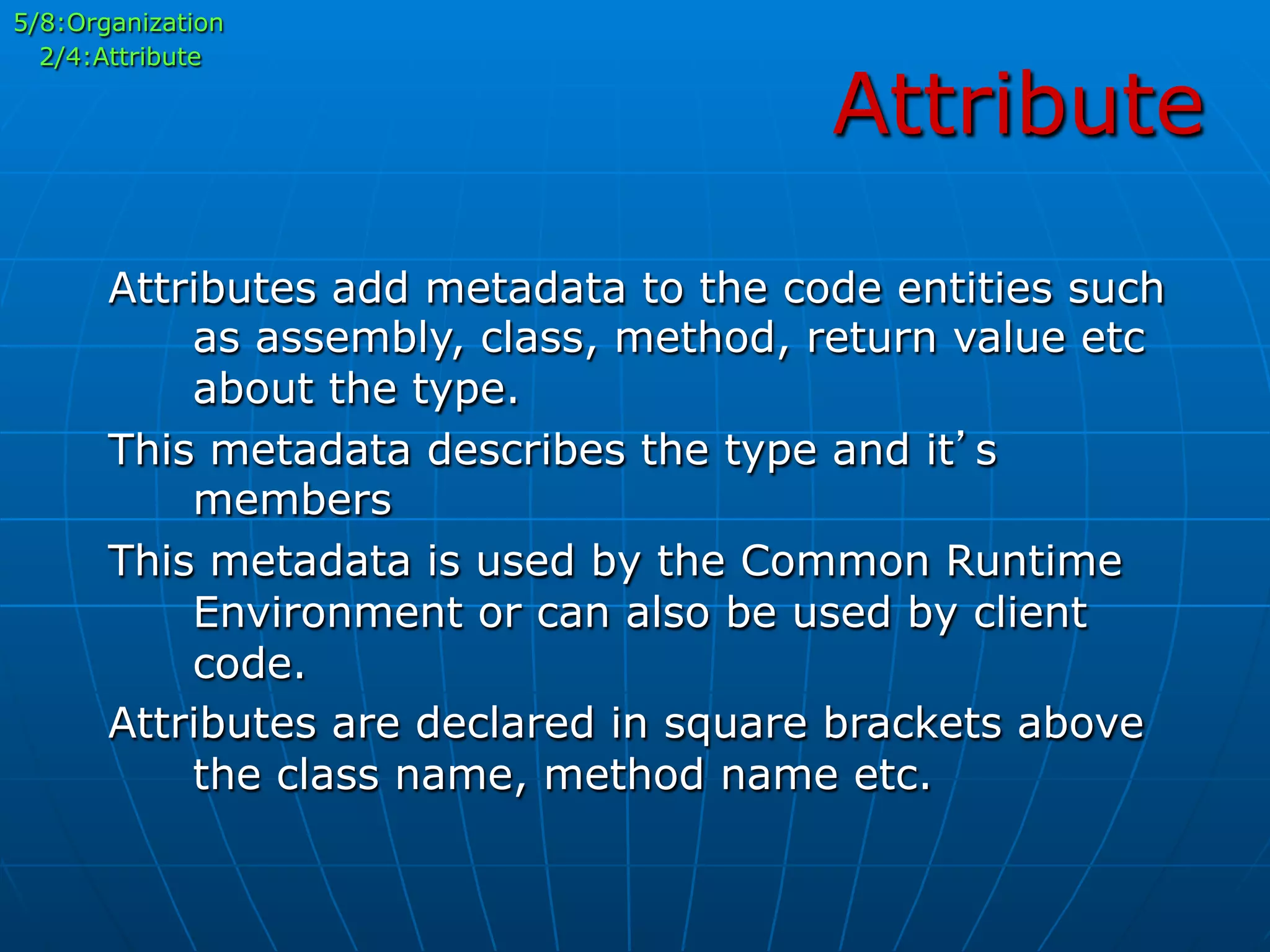
![Attribute
[Obsolete("Do
not
use
this")]
public
class
Myclass
{
public
void
disp()
{
System.Console.WriteLine("..");
}
}
class
Program
{
[STAThread]
//
means
thread
safe
for
COM
static
void
Main(string[]
args)
{
Myclass
mc
=
new
Myclass();
mc.disp();
System.Console.Read();
}
}
5/8:Organization
2/4:Attribute](https://image.slidesharecdn.com/understandingc-170517115205/75/Understanding-C-in-NET-41-2048.jpg)
